Before our trips to Korea, my knowledge of Korean food was pretty much limited to kimchi, bulgogi, and japchae. My exposure to the cuisine never really went beyond that in spite of having several Korean friends, including a Korean roommate for a couple of years. I think part of it is due to how damn good Korean barbecue is. It’s so delicious that it was pretty much all I ever looked for when eating at Korean restaurants. Bulgogi for my main course, and a plate of japchae on the side. That was it.
But thanks to our two trips to Seoul, in 2015 and 2017, my Korean food vocabulary has expanded to over 40 dishes. As delicious and universally appealing as Korean barbecue is, I’ve learned that there’s so much more to the cuisine than just bulgogi and galbi. Things like ganjang gejang, jokbal, and naengmyeonaren’t as well known outside of Korea but they are dishes well worth flying for. Ganjang gejang was particularly memorable. After waiting two years to try it, you’d think all that expectation would lead to disappointment, but it didn’t. Instead, it turned out to be even better than I thought. It blew me away.
If you’re visiting South Korea and looking to try something other than bulgogi, then I hope this post gives you a few ideas. To better organize this list, I’ve classified each dish as being restaurant food or street food, though some dishes may cross over.
Save This on Pinterest!
No time to read this now? Click on the red save button and pin it for later!
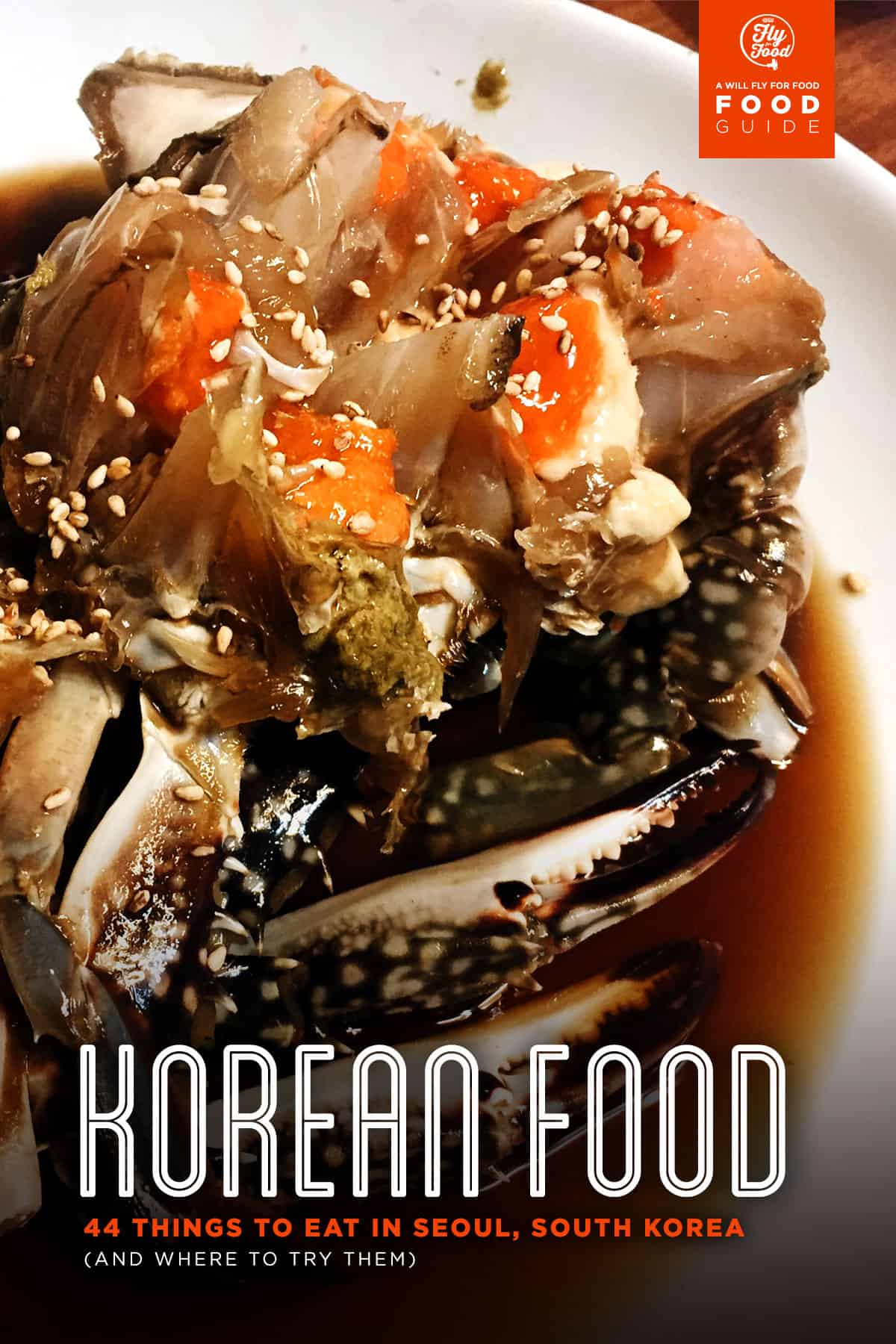
RESTAURANT FOOD
1. Banchan
Banchan refers to those delicious little side dishes served at the start of a Korean meal. I like to think of them as Korean tapas. They’re typically offered as ancillary dishes, but Sigol Bapsang in Itaewon serves them as the main course. There you’ll get at least 20 different kinds of banchan for just KRW 8,000 per person with rice and sundubu jjigae.
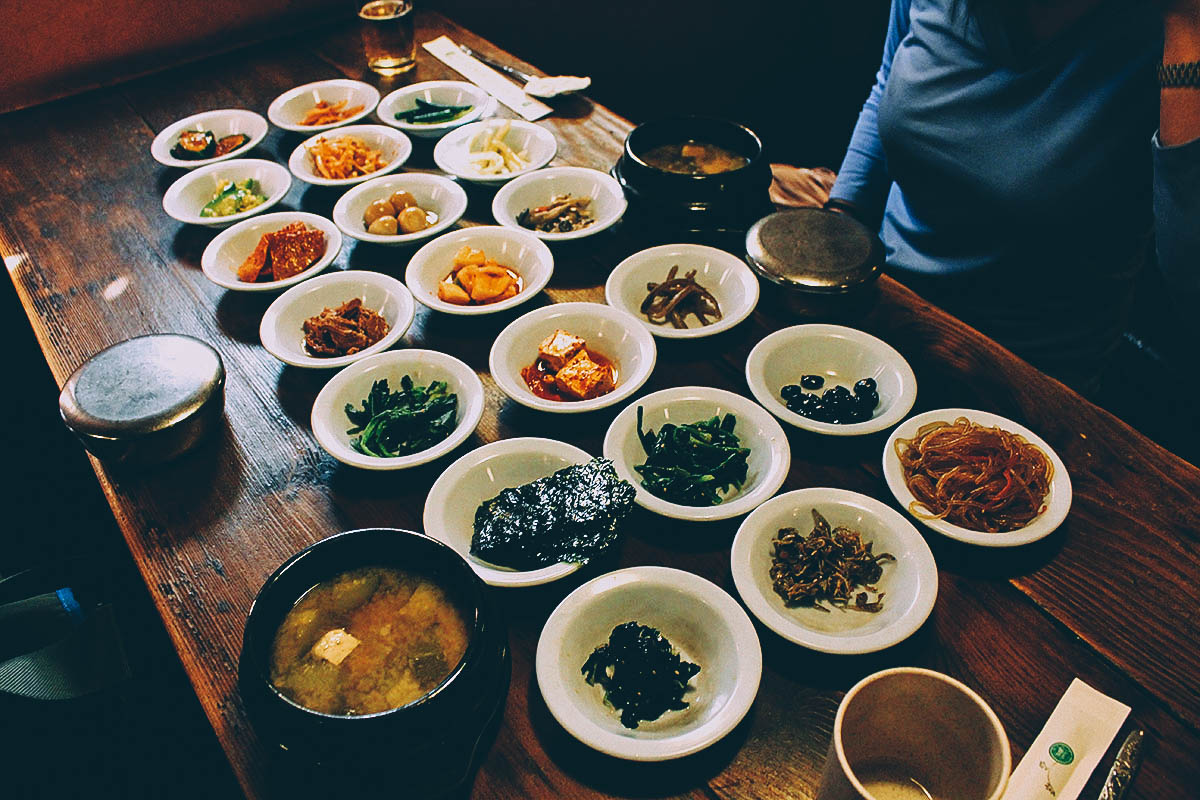

Where to Try it: Sigol Bapsang
Expect to Pay: Free with many Korean meals, KRW 8,000 for 20 kinds at Sigol Bapsang
Expect to Pay: Free with many Korean meals, KRW 8,000 for 20 kinds at Sigol Bapsang
2. Bibimbap
Like Korean barbecue, bibimbap is one of the most popular Korean dishes outside of the country. It literally means “mixed rice” and refers to a bowl of warm white rice topped with gochujang (Korean chili paste) and a variety of sauteed and seasoned vegetables like cucumber, soy bean sprouts, radish, spinach, and mushroom. An egg (raw or fried) and sliced meat, typically beef, are often added. The contents are then mixed together thoroughly before being eaten.
There are multiple variations of bibimbap, one of the most famous being Jeonju bibimbap. Grandma Yu’s Bibimbap is described as being one of the most authentic places in Seoul to try Jeonju bibimbap.
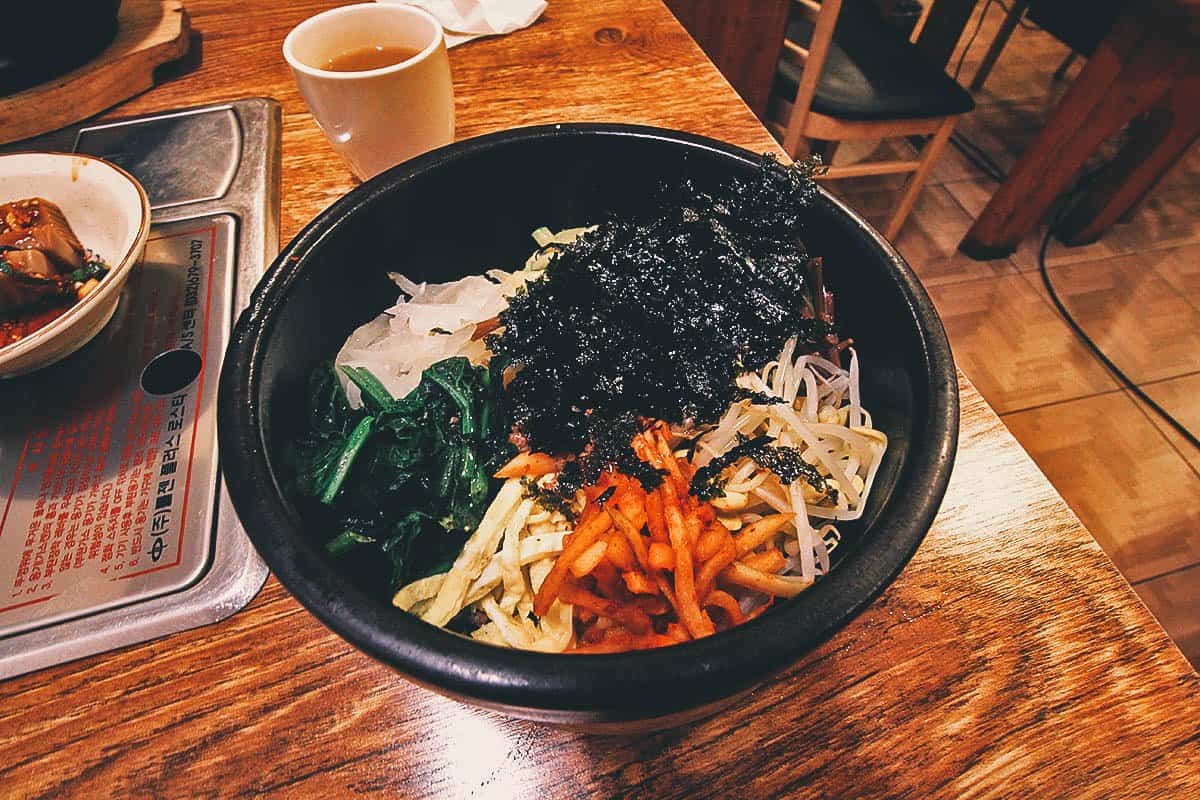

3. Bossam
Bossam refers to pork belly which is boiled in a broth with spices like star anise, ginger, scallion, garlic, and soybean paste, then thinly sliced. It’s served with a variety of side dishes and eaten as ssam – wrapped in vegetables like lettuce or perilla leaves. Bossam is a popular anju dish, meaning it’s a food typically consumed with alcohol like soju or beer.
Pictured below is a platter of bossam and jokbal at Manjok Ohyang Jokbal. The bossam is the lighter-colored rectangles of meat on the right side of the plate. We didn’t go but a recommended place to try it is at Bossam Alley, a cluster of bossam specialty restaurants in Jongno-gu.
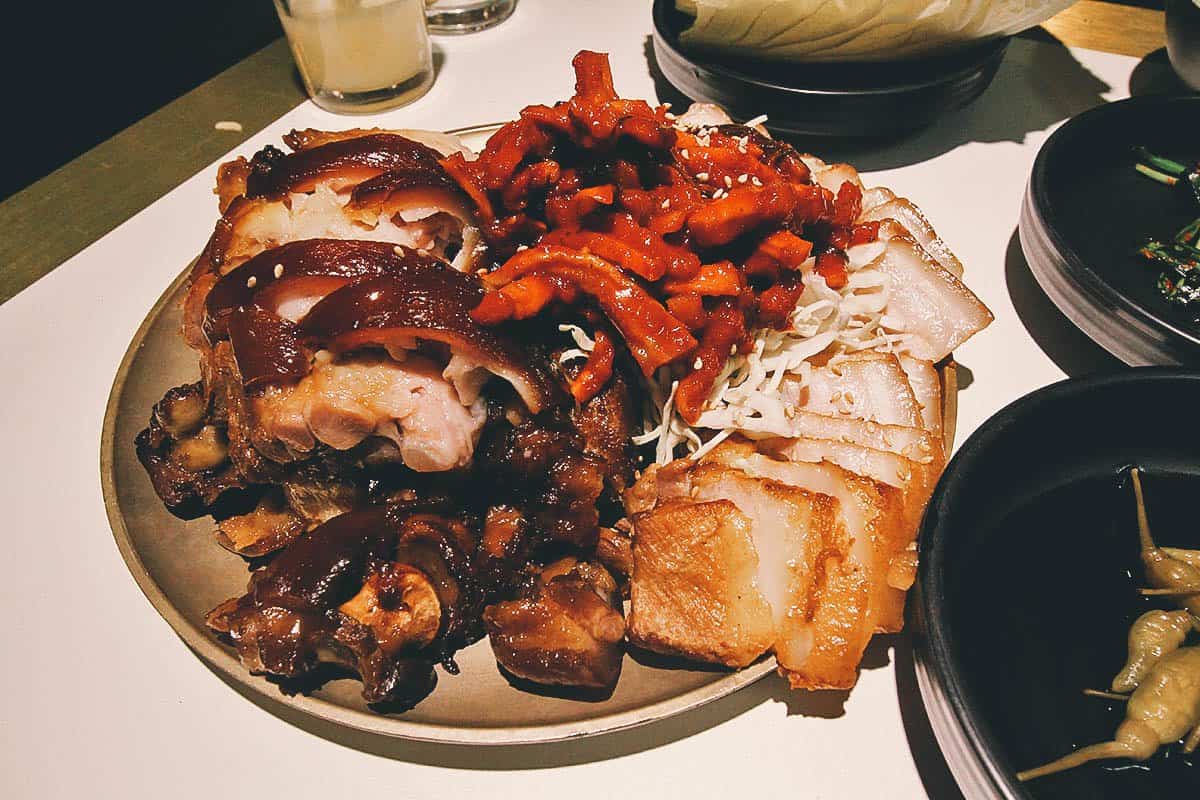

4. Chimaek (Korean Fried Chicken & Beer)
Chimaek is a compound word for chi-cken and maek-ju, the Korean word for “beer”, so it refers to the popular duo of Korean fried chicken and beer. It’s a combination that’s ultra-popular not just in Korea, but in many parts of the world as well. What makes Korean fried chicken so good is that it’s double-fried, resulting in crunchier and less greasy skin.
There are many popular chimaek restaurants in Seoul. We visited two – Han Chu Korean Fried Chicken & Beer and Oksang Dalbit – both of which we’re happy to recommend.
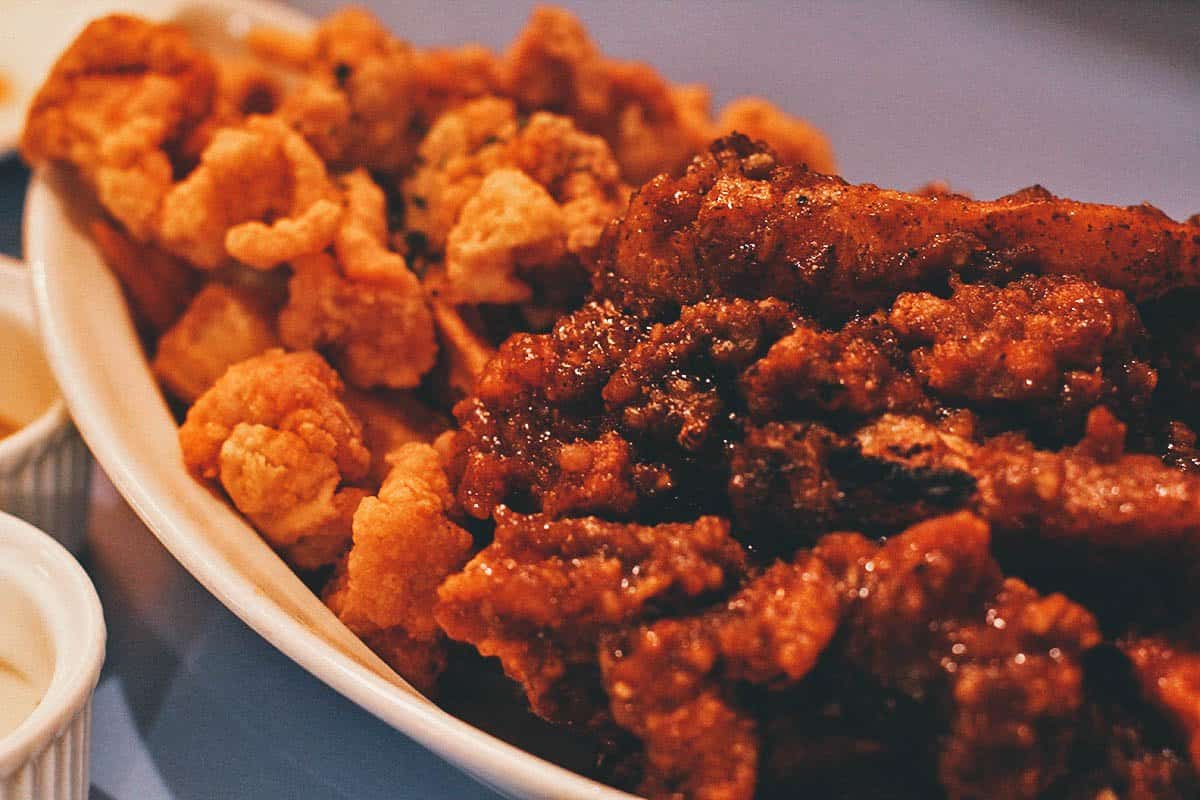

Where to Try it: Han Chu Korean Fried Chicken & Beer, Oksang Dalbit
Expect to Pay: Around KRW 20,000 per order of fried chicken and beer
Expect to Pay: Around KRW 20,000 per order of fried chicken and beer
5. Chueotang
Chueotang is a soup made from pond loach, a type of freshwater mudfish. The fish is boiled in water until tender, then sieved to remove all its bones and skin. The fish meat is boiled again with beef or chicken broth and seasoned with gochujang (red chili paste), doenjang (soybean paste), grated ginger, and ground black pepper, before being served in a soup with vegetables, mushroom, fried tofu, rice, and noodles.
One of the best places to try chueotang is at Yonggeumok, a restaurant in Jung-gu that’s been specializing in this dish for over 85 years.
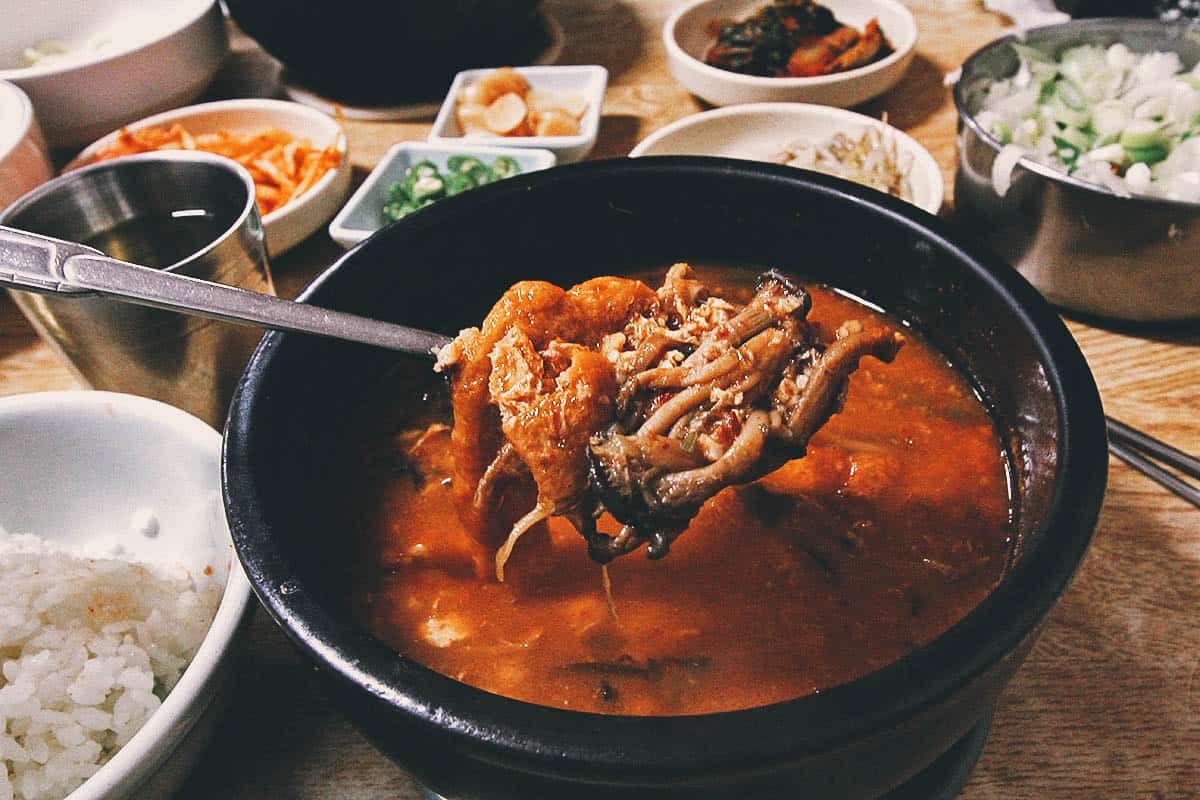

6. Ganjang Gejang
Some people have described ganjang gejang as the ultimate Korean dish. I would agree. Ganjang gejang is raw crab marinated in soy sauce. To make it, crabs are thoroughly cleaned then put in an earthenware crock where they’re salted for a period of about six hours. A marinade of soy sauce, sugar, sesame oil, scallions, ginger, garlic, and red chili pepper is boiled briefly then poured over the salted crabs. An hour later, the marinade is removed, reboiled, and again poured over the crabs in a process that’s repeated several times before the dish is chilled and consumed. Eaten with rice, it is absolutely divine.
Like Korean barbecue, ganjang gejang is an expensive dish, around KRW 30,000 per small crab. We had it at Wonjo Masan Halmae Agujjim, a restaurant located in Ganjang Gejang Alley which is a cluster of restaurants specializing in this dish.
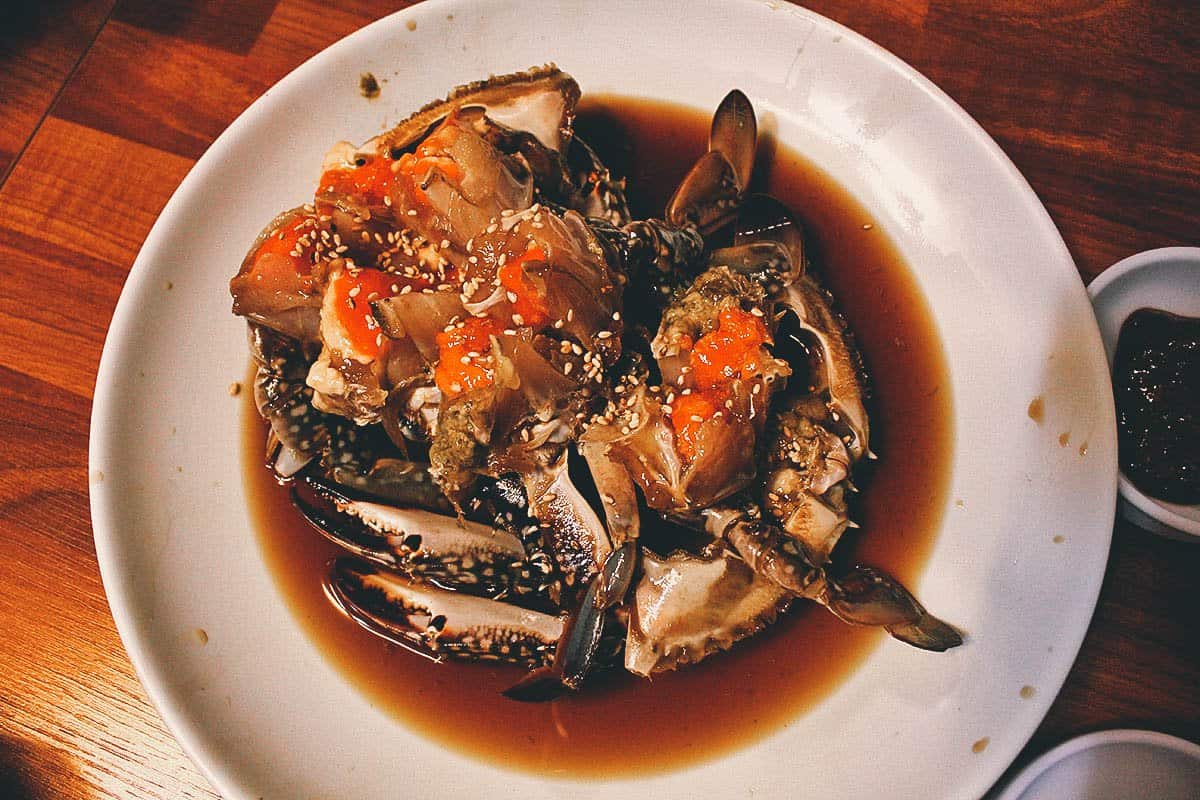

7. Gogigui (Korean BBQ)
When people think of Korean food, kimchi and barbecue are probably the first things that come to mind. Gogigui means “meat roast” and refers to the popular method of grilling meat like beef, pork, or chicken on gas or charcoal grills usually built into your dining table. Meat can be marinated or unmarinated, among the most popular being bulgogi (thin marinated slices of beef or pork) and galbi (marinated beef or pork ribs).
There are countless gogigui restaurants in Seoul. We tried two – Yeontabal BBQ Restaurant and WooSung Galbi. Both were excellent.
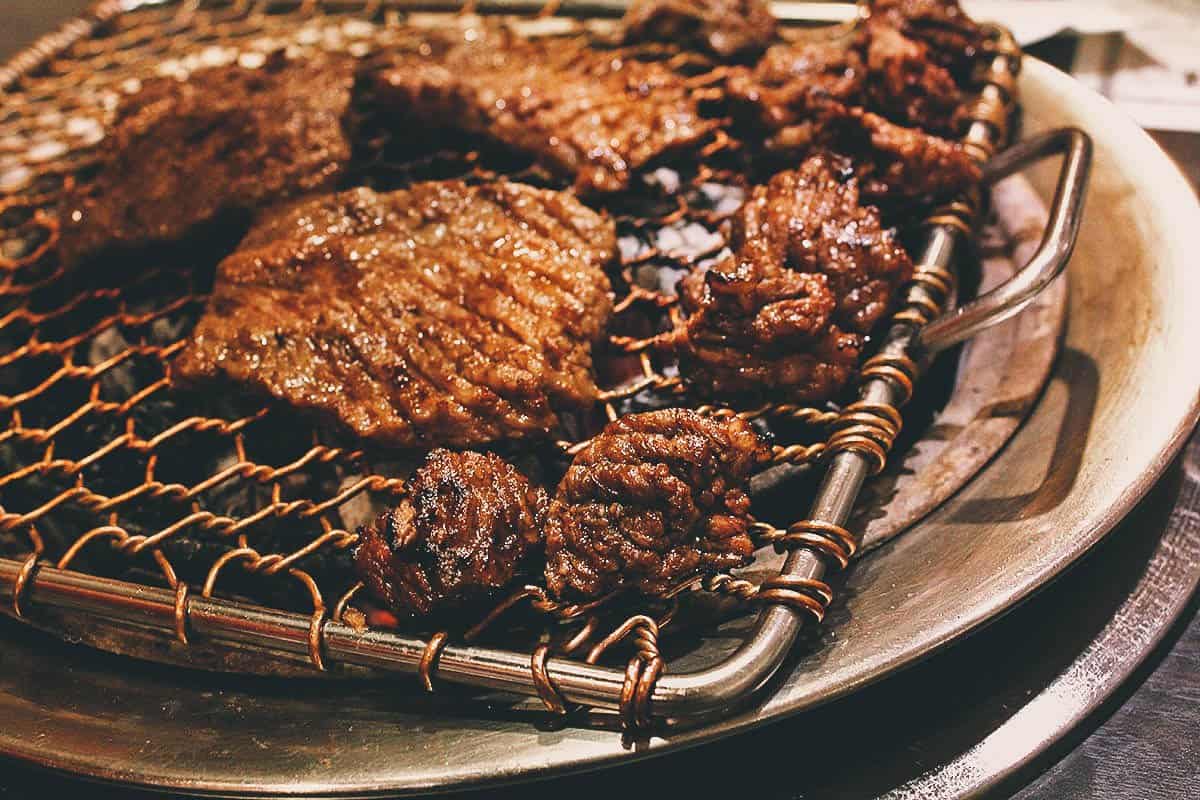
Meat is typically expensive in Korea, around KRW 30,000 per order, and you usually need to get a minimum of two orders per cut of meat. We were pleased to find WooSung Galbi which offers just two items on their menu – pork galbi and pork rinds – each for just KRW 13,000 per order. That’s a great deal for Korean BBQ in Seoul.
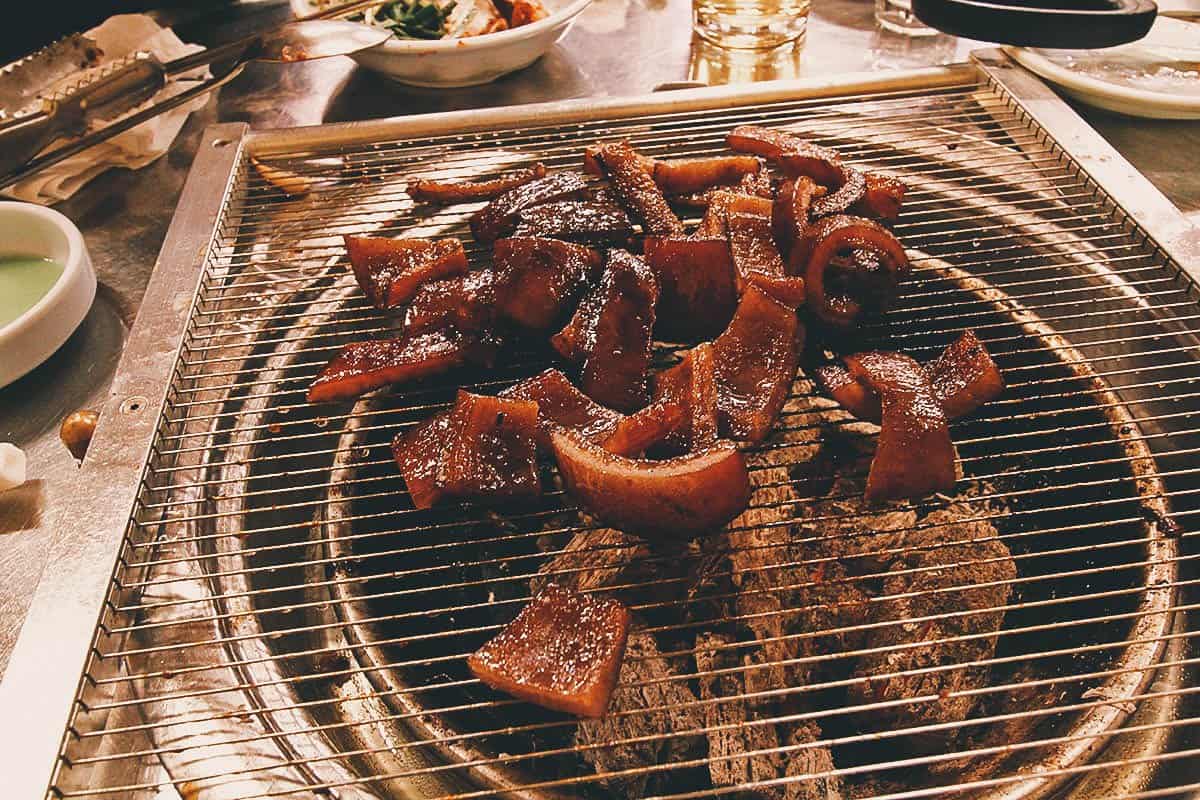

Meat is typically expensive in Korea, around KRW 30,000 per order, and you usually need to get a minimum of two orders per cut of meat. We were pleased to find WooSung Galbi which offers just two items on their menu – pork galbi and pork rinds – each for just KRW 13,000 per order. That’s a great deal for Korean BBQ in Seoul.

8. Gomtang
Gomtang is beef bone soup. It’s made by simmering various beef parts like ribs, brisket, oxtail, and ox head or bones over a low flame. Rice is added to the soup and you can season the broth to taste with salt and minced green onion at your table.
The special gomtang pictured below is made with beef tripe. It’s offered at Hadongkwan, a 78-year old restaurant in Myeongdong that’s known for serving some of the best gomtang in Seoul.
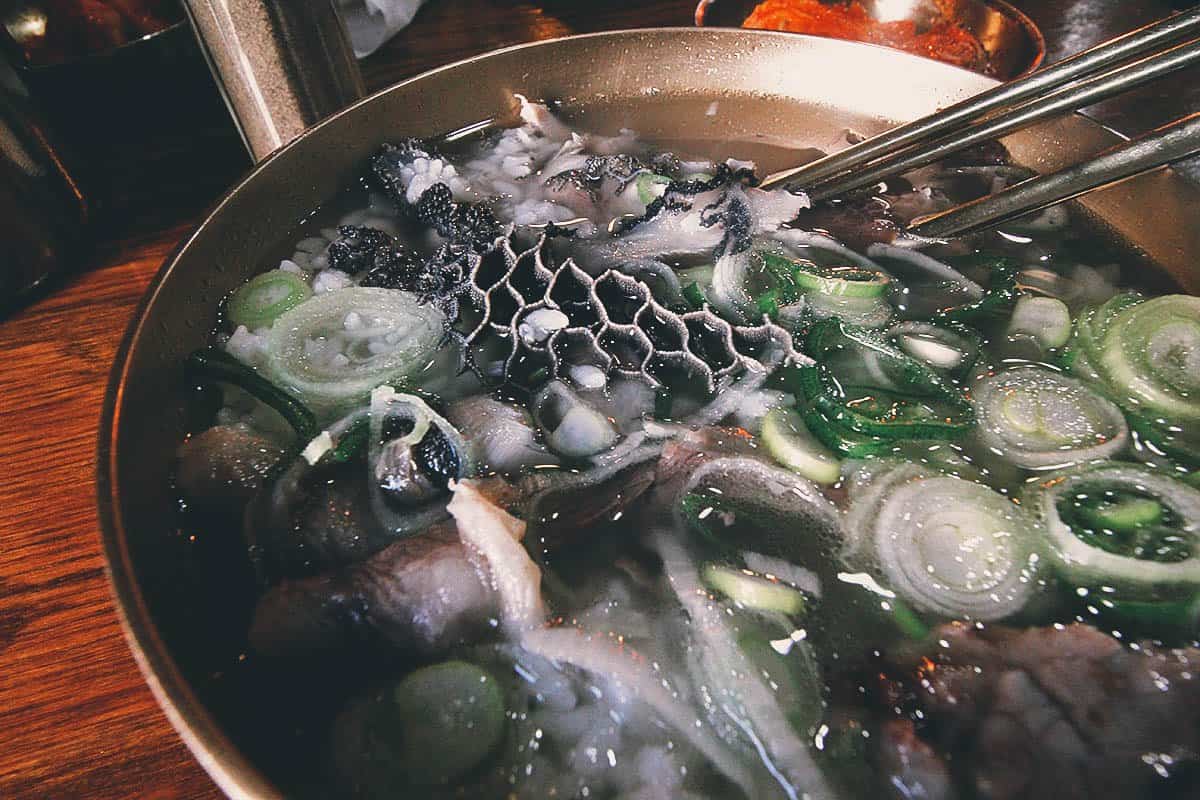

9. Japchae
Japchae is one of the most popular dishes in Korean cuisine. It refers to sweet and savory stir-fried glass noodles made with dangmyeon (sweet potato starch cellophane noodles) and topped with assorted vegetables, meat, and mushrooms. It’s seasoned with soy sauce and sesame oil, and commonly served as banchan.
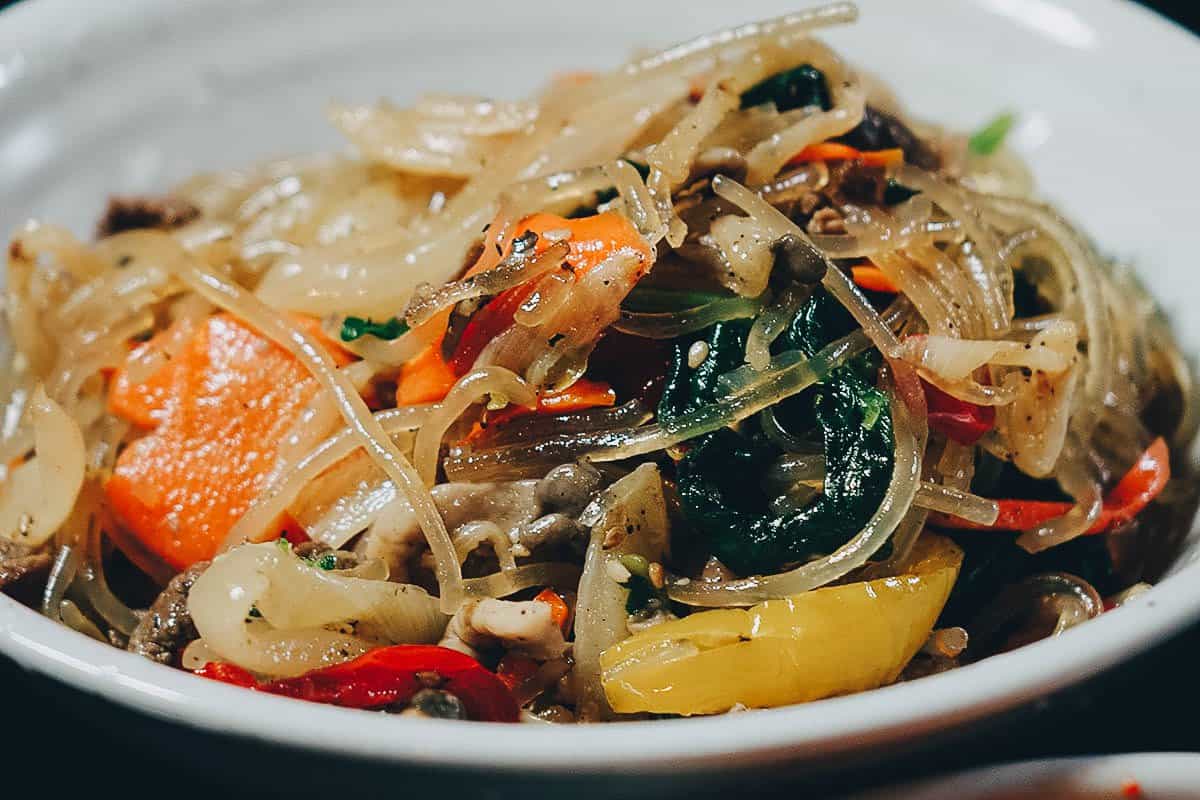

By 최광모 (Own work) [CC BY-SA 4.0], via Wikimedia Commons / Processed in Photoshop and Lightroom
Where to Try it: Restaurants serving traditional Korean food
Expect to Pay: Typically free with your Korean meal
Where to Try it: Restaurants serving traditional Korean food
Expect to Pay: Typically free with your Korean meal
10. Jjukumi
Jjukumi is a notoriously spicy dish of stir-fried baby octopuses marinated in a red chili gochugaru sauce. I have a high tolerance for spicy food and I found this dish to be devilishly hot. It’s considered spicy even by local standards so only try this dish if you have a fondness for spicy food.
The best place to try it is at Na Jeong-sun Halmae Jjukkumi. It’s in Jjukumi Alley which is a cluster of restaurants specializing in this dish. There are several restaurants there but Na Jeong-sun Halmae Jjukkumi is the original and still considered to be the best.
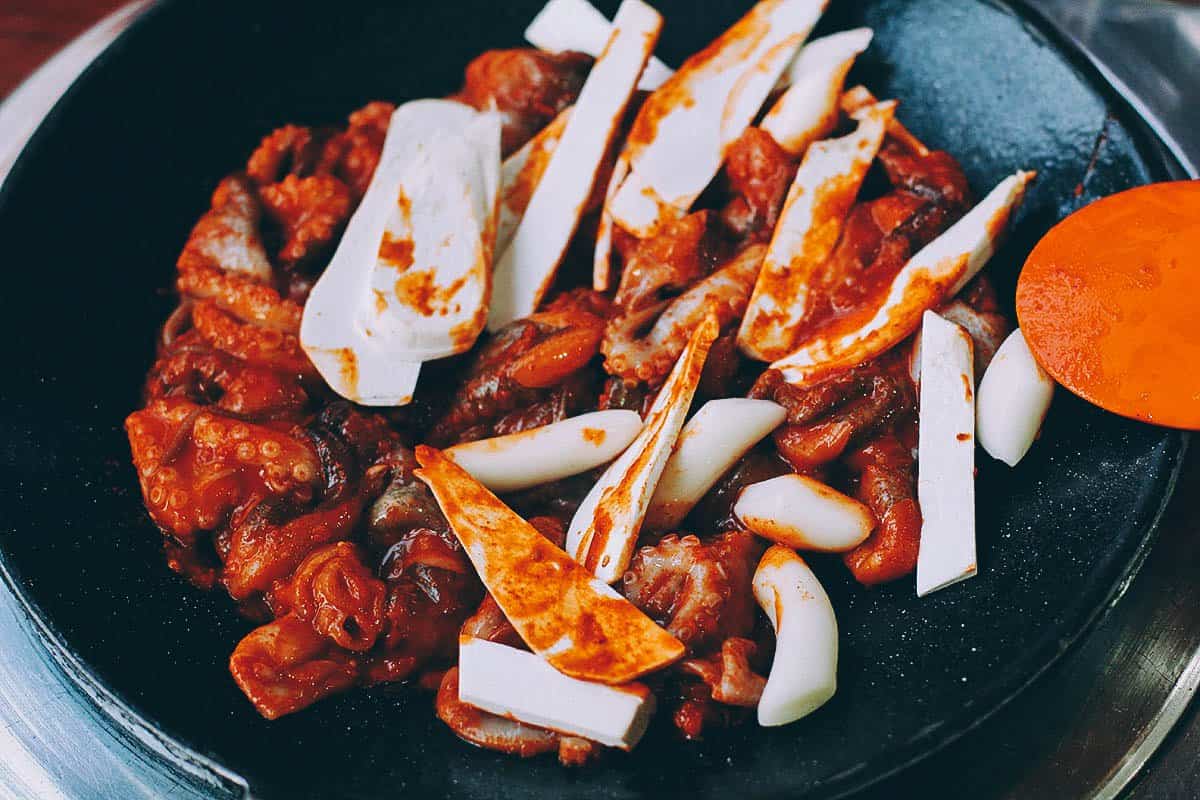

11. Jokbal
Jokbal is a dish of pig’s trotters (feet) cooked in soy sauce, ginger, garlic, and rice wine, and can contain other ingredients like onion, leeks, garlic, cinnamon, and black pepper. The trotters are simmered until fork tender, then deboned and cut into thick slices. Like bossam, jokbal is a popular anju dish often eaten with soju or beer.
Here’s that same platter of bossam and jokbal at Manjok Ohyang Jokbal. The jokbal is on the left side of the plate. Manjok Ohyang Jokbal is considered by many to be the best place to try jokbal in Seoul.


12. Kalguksu
Kalguksu means “knife noodles” and refers to a noodle dish consisting of handmade, knife-cut wheat flour noodles served in a large bowl with broth and other ingredients. Its name comes from the fact that the noodles are not extruded or spun, but cut. The noodles are made with dough from wheat flour and eggs which is rolled out thinly and cut into long strips. Ingredients like dried anchovies, shellfish, and kelp are simmered for several hours to prepare the broth, before the noodles and vegetables are added and boiled together.
Myeongdong Kyoja, which has been in business for over 50 years, is said to serve some of the city’s best kalguksu. It’s located in the popular shopping district, making it a good place to have lunch or dinner when you’re in the area.
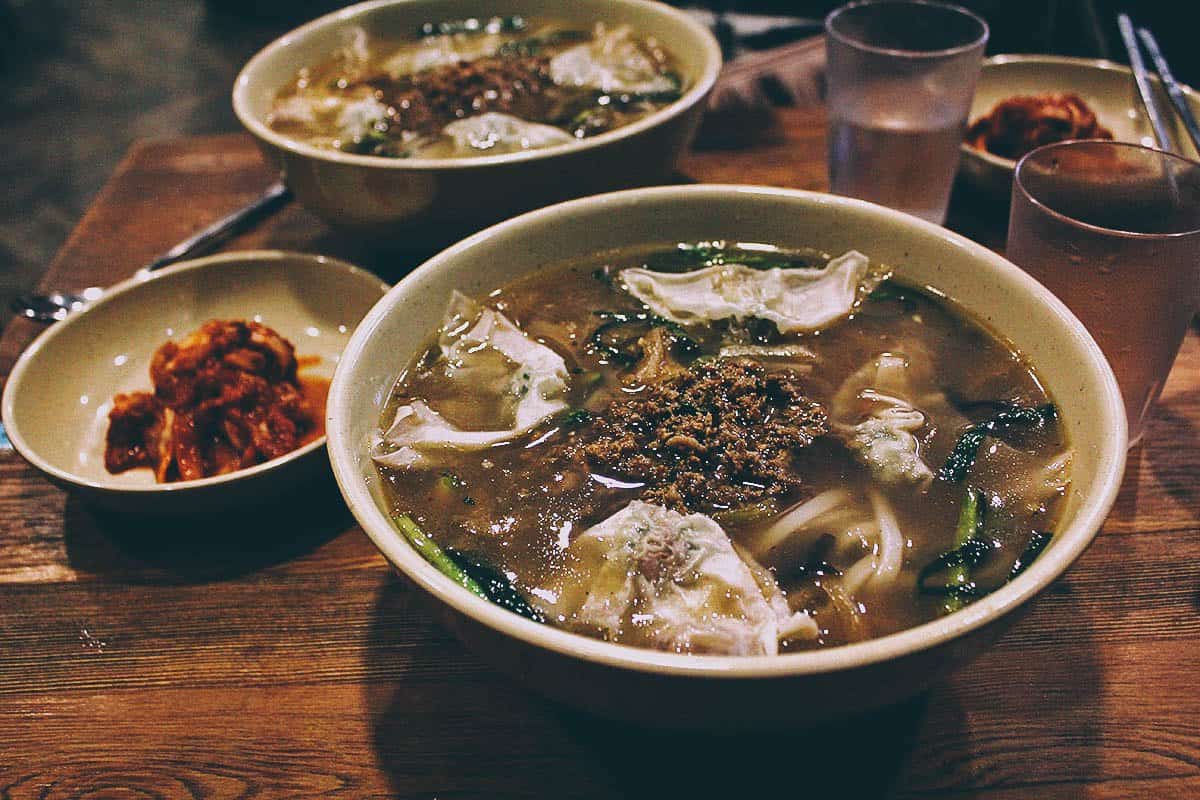

13. Kimchi
Without question, kimchi is the one dish that’s synonymous with Korean cuisine and culture. A staple in Korean cuisine, kimchi is a traditional side dish made from salted and fermented vegetables – most commonly cabbage and Korean radishes – with a variety of seasonings like chili powder, scallions, garlic, ginger, and jeotgal (salted seafood). There are hundreds of varieties of kimchi made using different vegetables as the main ingredients. It’s considered a national dish of both North and South Korea.
Kimchi is typically served as one of many banchan side dishes at the start of your meal. Pictured below are different types of kimchi being sold at Gwangjang Market.


Where to Try it: Any restaurant or market that serves Korean food
Expect to Pay: Typically free with your meal
Expect to Pay: Typically free with your meal
14. Makgeolli
Makgeolli is a sweet-sour alcoholic beverage made from rice or wheat mixed with nuruk, a Korean fermentation starter. It’s milky and off-white in color and has about 6–8% alcohol by volume. My Korean sister-in-law recommended we drink it with our seolnongtang and that’s what we did. They went very well together so I think it’s something you can pair with similarly hot and hearty soups or stews.
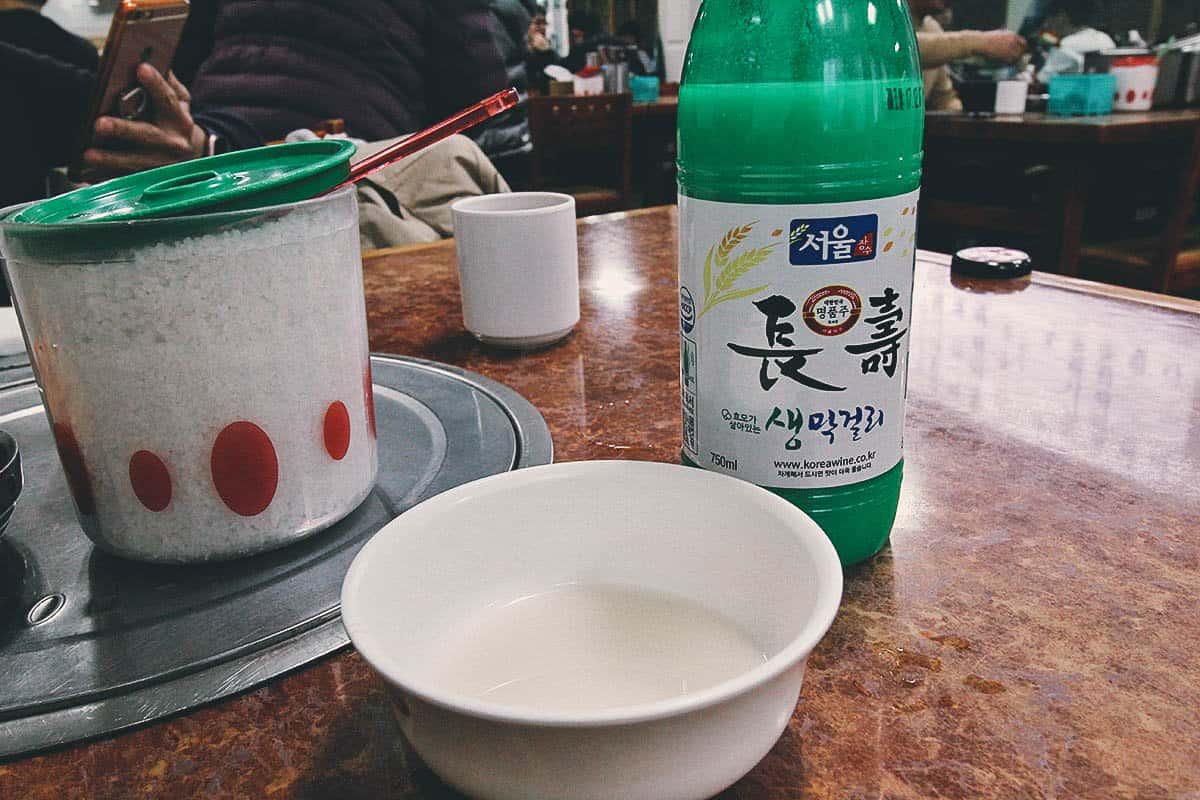

Where to Try it: Any Korean restaurant that serves alcoholic beverages
Expect to Pay: KRW 4,000 per 750 ml bottle
Expect to Pay: KRW 4,000 per 750 ml bottle
15. Naengmyeon
Naengmyeon is a Korean dish of long, thin handmade noodles typically made from buckwheat, though the noodles can be made from various other ingredients as well like potatoes, sweet potatoes, arrowroot starch, and kudzu. Naengmyeon is originally a North Korean delicacy that became popular throughout Korea after the Korean War. It’s traditionally served in a large stainless-steel bowl with a tangy iced broth.
Pictured below is a bowl of mul naengmyeon from Woo Lae Oak, one of Korea’s oldest restaurants. It’s often cited as being one of the best places to try naengmyeon in Seoul.
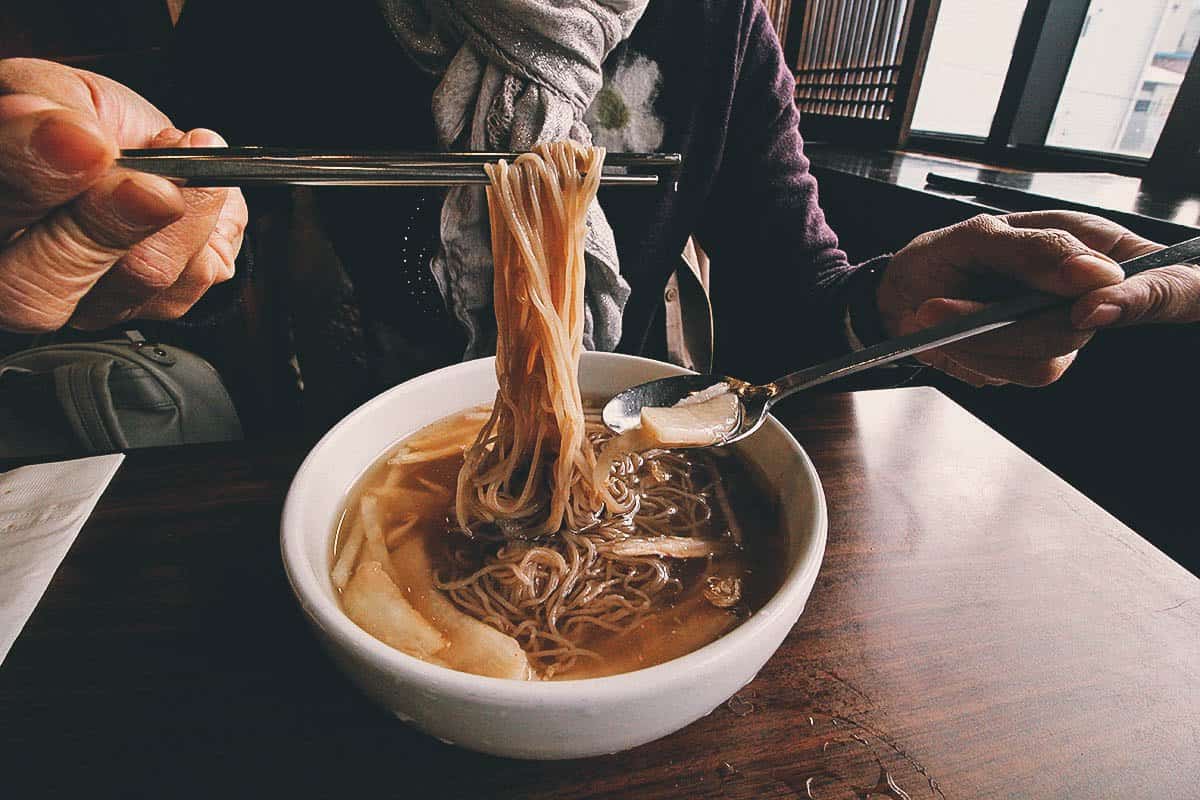
Woo Lae Oak offers two types of naengmyeon – the mul naengmyeon above and this bibim naengmyeon which is a less soupy version topped with a spicy dressing made primarily from gochujang.
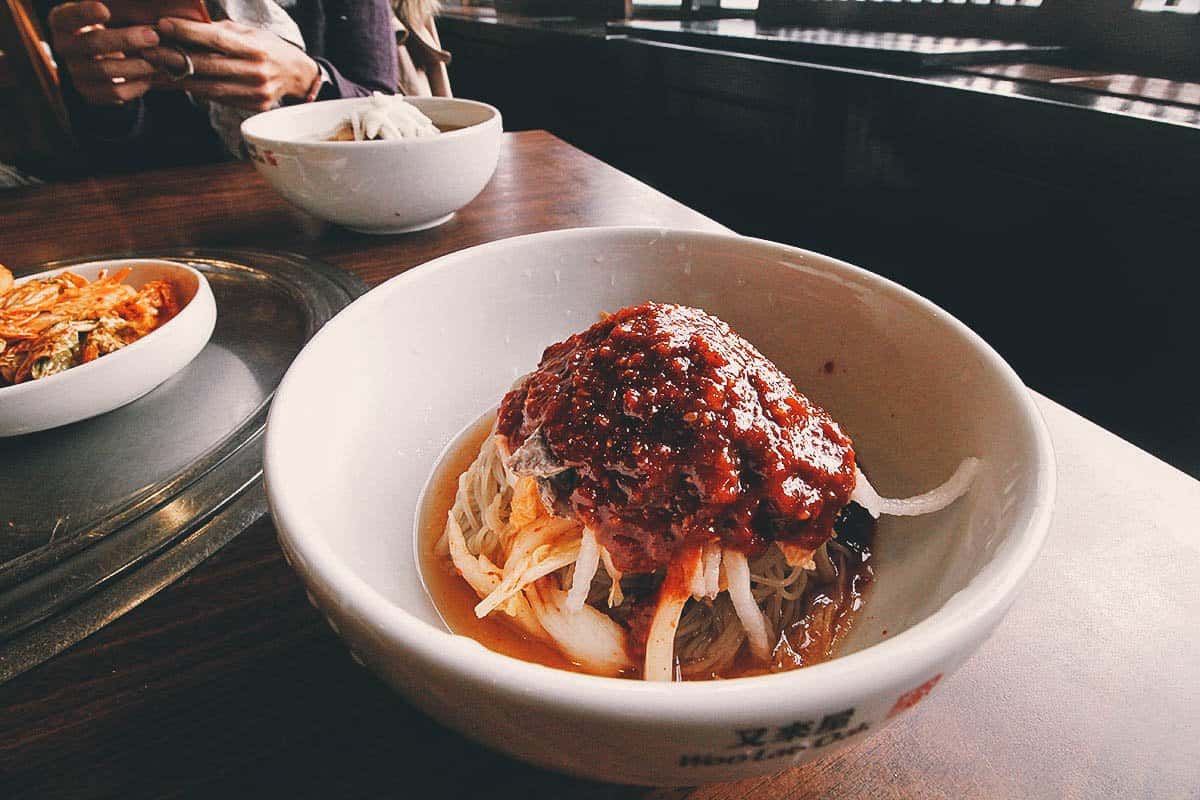

Woo Lae Oak offers two types of naengmyeon – the mul naengmyeon above and this bibim naengmyeon which is a less soupy version topped with a spicy dressing made primarily from gochujang.

16. Nakji Bokkeum
I love octopus and squid so nakji bokkeum is one of my favorite Korean dishes. It’s a stir-fried dish made with chopped octopus and vegetables that have been marinated in gochujang, soy sauce, garlic, salt, and sugar. A version of this dish made with squid instead of octopus is called ojingeo bokkeum. I enjoy them both.
A good place to try nakji bokkeum in Seoul is at Halmae Nakji in Myeongdong. One of Seoul’s oldest restaurants, they’ve been making nakji bokkeum for over 67 years so you know they’re doing something right.
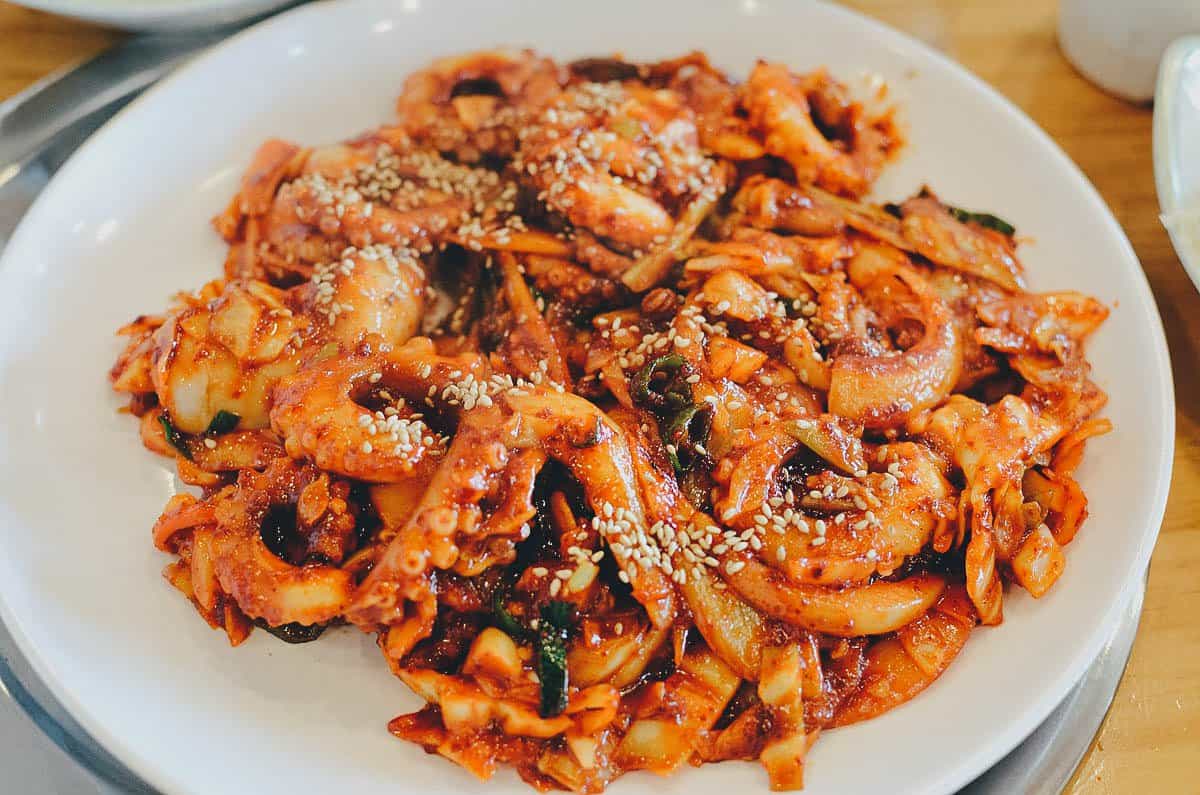

By 박家상민 [CC BY 4.0], via Wikimedia Commons / Processed in Photoshop and Lightroom
Where to Try it: Myeongdong Halmae Nakji
Expect to Pay: KRW 23,000 for a small plate
Where to Try it: Myeongdong Halmae Nakji
Expect to Pay: KRW 23,000 for a small plate
17. Pajeon
A pajeon is a pancake-like dish made with scallions as its predominant ingredient. It’s usually accompanied by a variety of ingredients like beef, pork, kimchi, squid, shrimp, and other seafood.
We had this pajeon at Tosokchon. It was great though Tosokchon is known more for its samgyetang. We didn’t go but I read that Nakso Pajeon is one of the best places to try pajeon in Seoul.
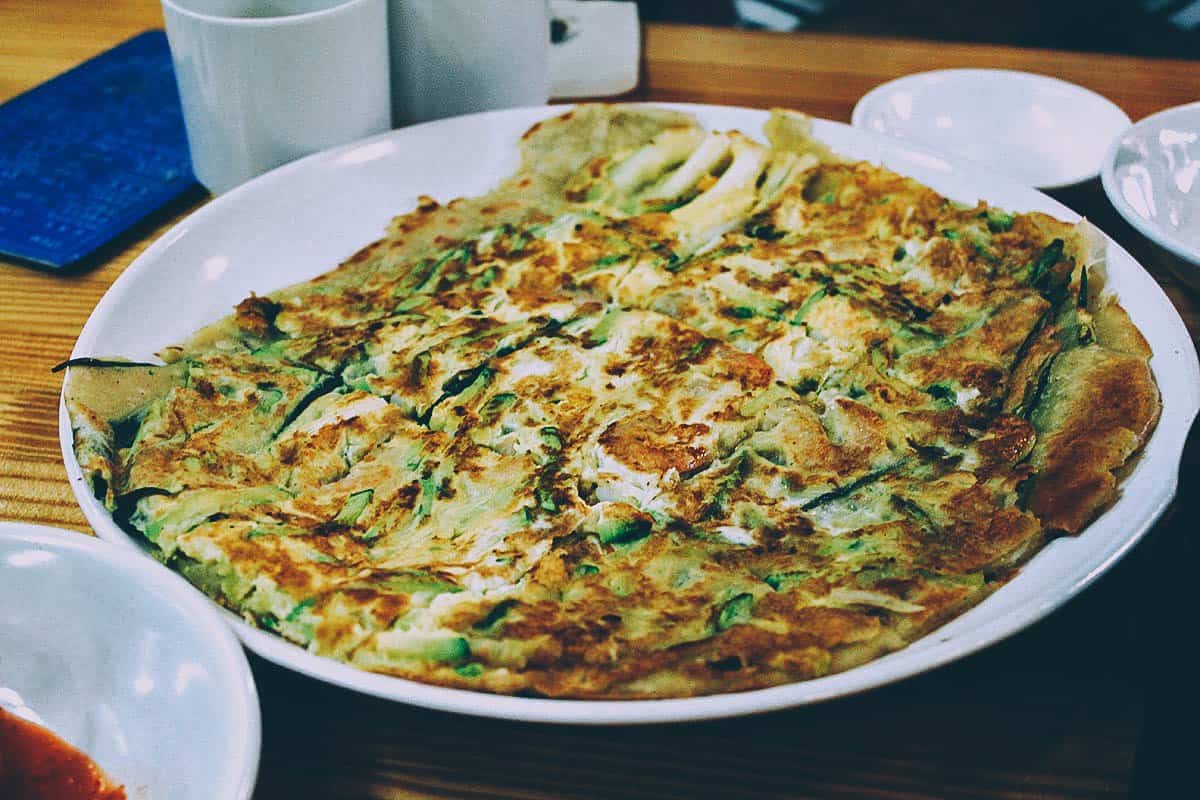

18. Samgyetang
Samgyetang literally means “ginseng chicken soup”. It’s a hot soup made from a whole young chicken stuffed with glutinous rice, then boiled in a broth of Korean ginseng, jujube fruits, garlic, ginger, and various herbs and condiments. A popular summer dish, it’s said that eating samgyetang replenishes lost heat and boosts your energy by facilitating blood flow in the internal organs and helping lower body heat by emitting sweat.
Tosokchon near Gyeongbokgung is said to serve some of the best samgyetang in the city. They offer two versions – one with regular chicken and another made with black chicken (pictured below).
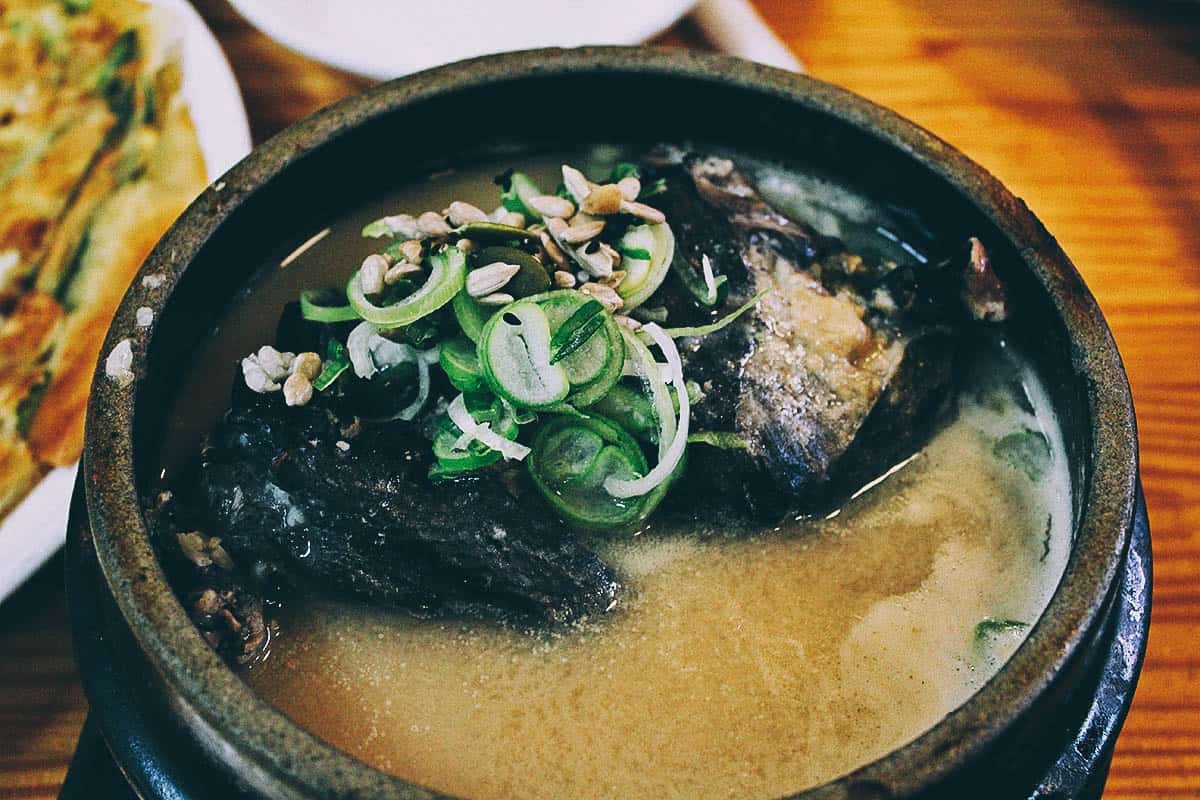

19. Sannakji
Sannakji is Korea’s infamous dish of octopus sashimi. As you can see in the video below, what makes it controversial is the fact that the tentacles are still wriggling. The animal is already dead having been chopped up into itty bitty pieces, but the tentacles still move because the ganglia are still intact. They’re capable of operating independently of the octopus and reacting to stimuli, hence the continued movement.
One of the best places to try sannakji is at Noryangjin Fish Market. You can buy it from one of the many vendors and have it prepared at a restaurant upstairs.
Where to Try it: Noryangjin Fish Market
Expect to Pay: Around KRW 10,000 per small octopus (with preparation)
Expect to Pay: Around KRW 10,000 per small octopus (with preparation)
20. Seolnongtang
Seolnongtang is ox bone soup. It’s made by boiling beef shank bones for several hours, even up to an entire day. This slow simmering process gradually extracts the flavor from the bones, turning the broth cloudy and milky white. Brisket and other cuts of beef are then added to the broth along with rice and soft wheat noodles. Salt, ground black pepper, and chopped spring onions are made available on your table so you can season the soup to taste.
Pictured below is a bowl of seolnongtang from Imun Seolnongtang, officially Seoul’s oldest restaurant at over 113 years old. This place is an institution so if you’re going to try seolnongtang, then it should be here. Be sure to enjoy it with a bottle of makgeolli as well.
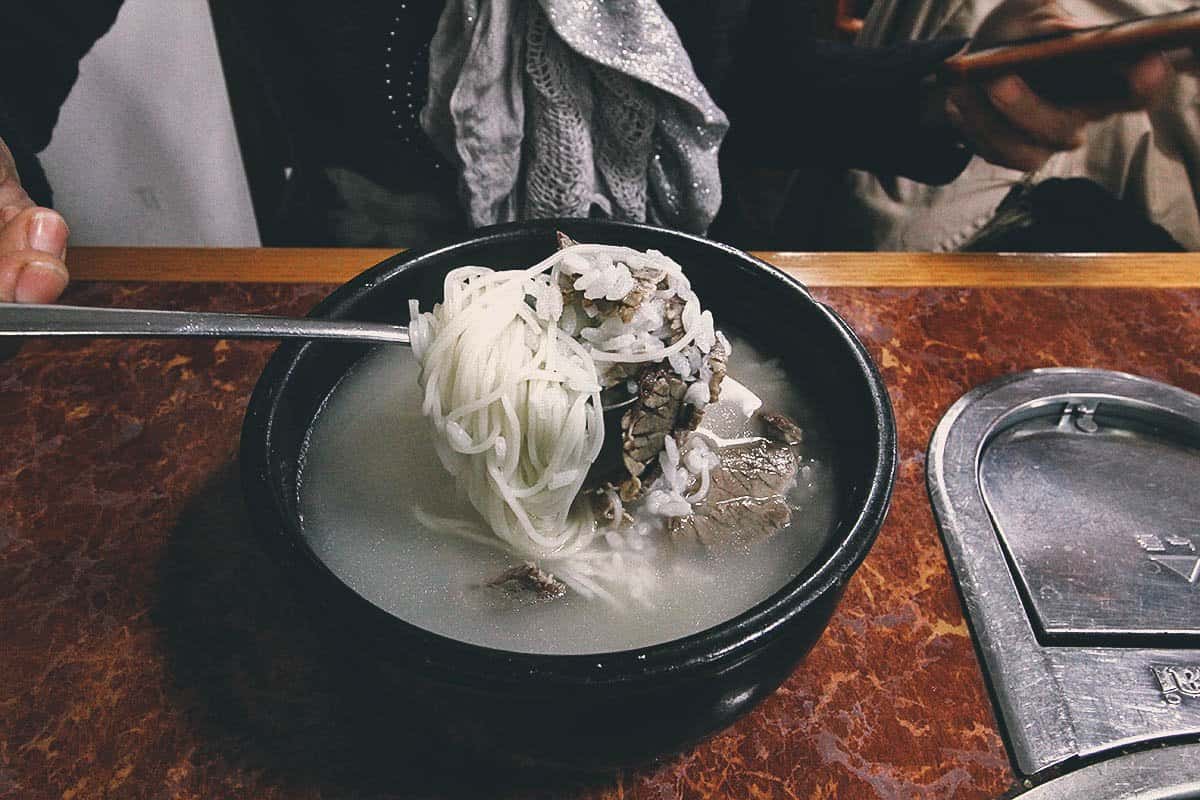

21. Sundubu Jjigae
Sundubu Jjigae is soft tofu stew. It’s made with freshly curdled soft tofu, vegetables, and gochujang (chili paste) or gochugaru (chili powder). It can sometimes contain other ingredients as well like mushroom, onion, seafood, meat, and a raw egg. It’s typically served at the start of your meal with a few plates of banchan and rice.
We’ve never ordered sundubu jiggae but it was served to us a couple of times to accompany our meal along with some banchan. I believe it’s something you can order at many Korean restaurants. I googled “best sundubu jjigae” and this restaurant – Jaedong Sundubu – frequently comes up.
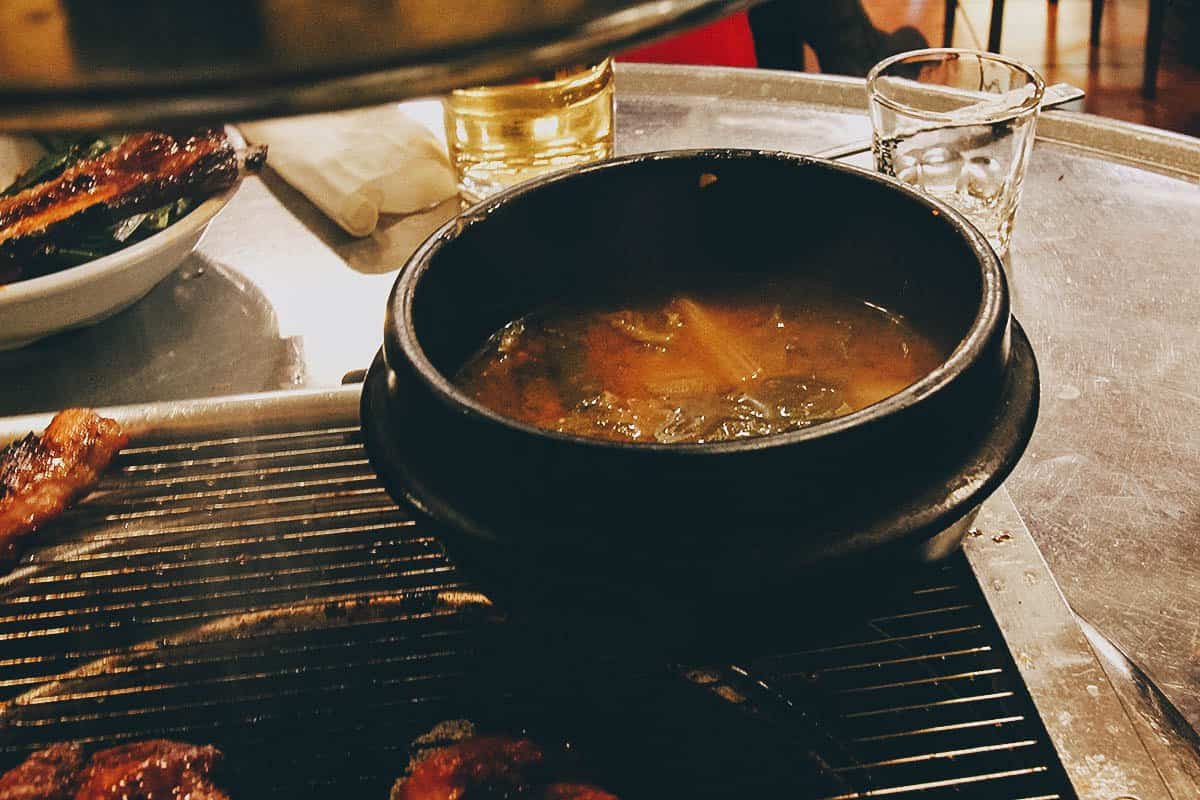

STREET FOOD
22. Beongdegi
I didn’t want to start the street food section of this post with something as exotic as this, but the dishes are listed in alphabetical order so I had no choice. 😆 Beongdegi is stewed silkworm larvae. It isn’t pretty but it actually tastes better than it looks. It’s soft, nutty, and very juicy. I read that beongdegi is a dying street food snack but you may chance upon them at Nandaemun or Gwangjang Market. We had a cup of these at the Jinhae Cherry Blossom Festival for KRW 3,000.
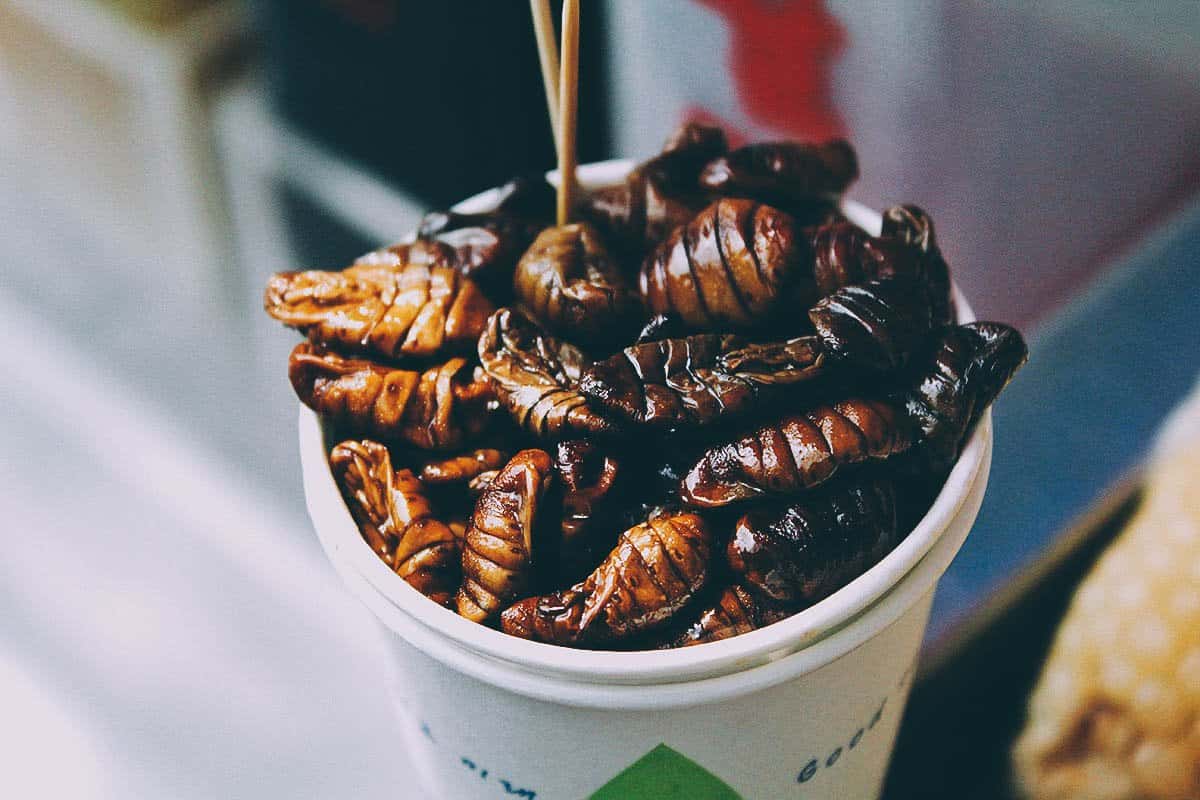

Where to Try it: Nandaemun or Gwangjang Market
Expect to Pay: Around KRW 3,000 per cup
Expect to Pay: Around KRW 3,000 per cup
23. Bindaetteok
Bindaetteok is a mung bean pancake. It’s made by grinding soaked mung beans and adding vegetables like green onions and kimchi, perhaps some pork, then pan-frying it into a round, flat shape. It’s served with a dipping sauce made with soy sauce, vinegar, water, and ground pine nuts. We didn’t try it but a great place to have bindaetteok is at Gwangjang Market. There are several vendors there offering this dish.
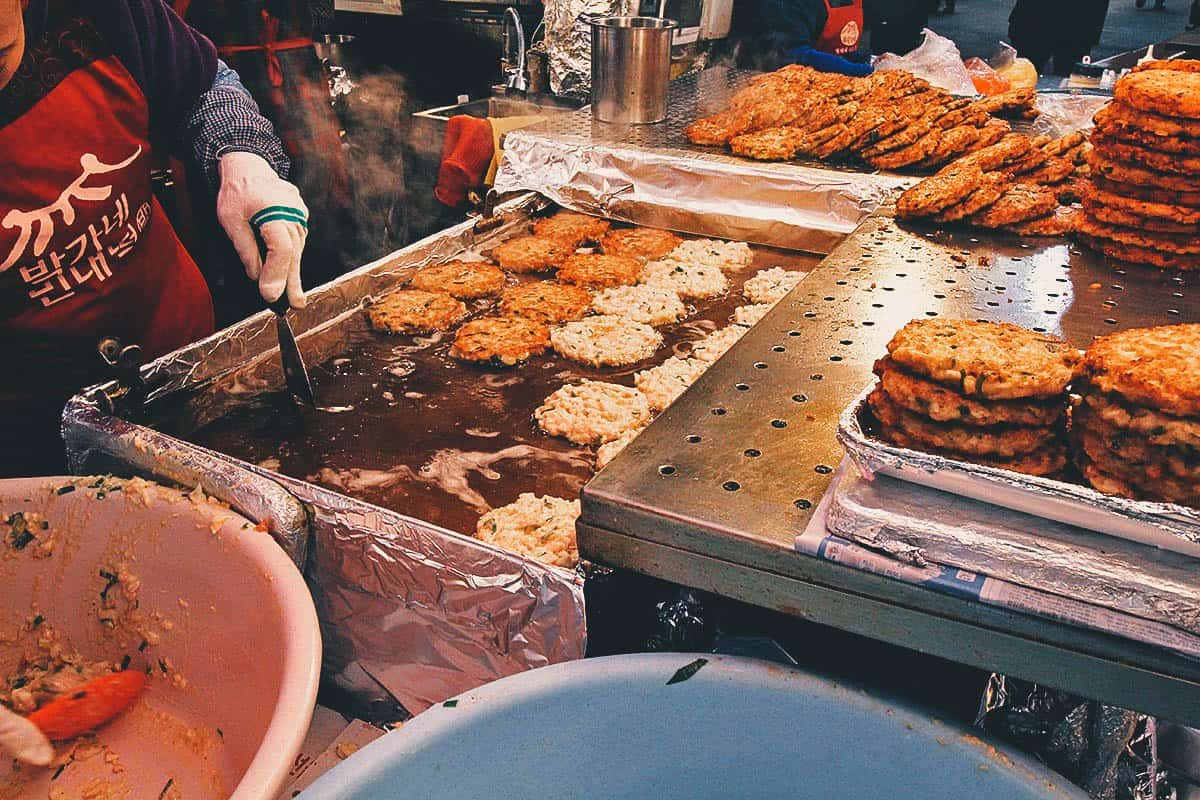

Where to Try it: Gwangjang Market
Expect to Pay: Around KRW 5,000 per order
Expect to Pay: Around KRW 5,000 per order
24. Crispy Crablets
We didn’t try these crispy crablets either but I read they have a texture similar to soft shell crabs. They’re just lightly seasoned too so you get the full flavor of the crabs.
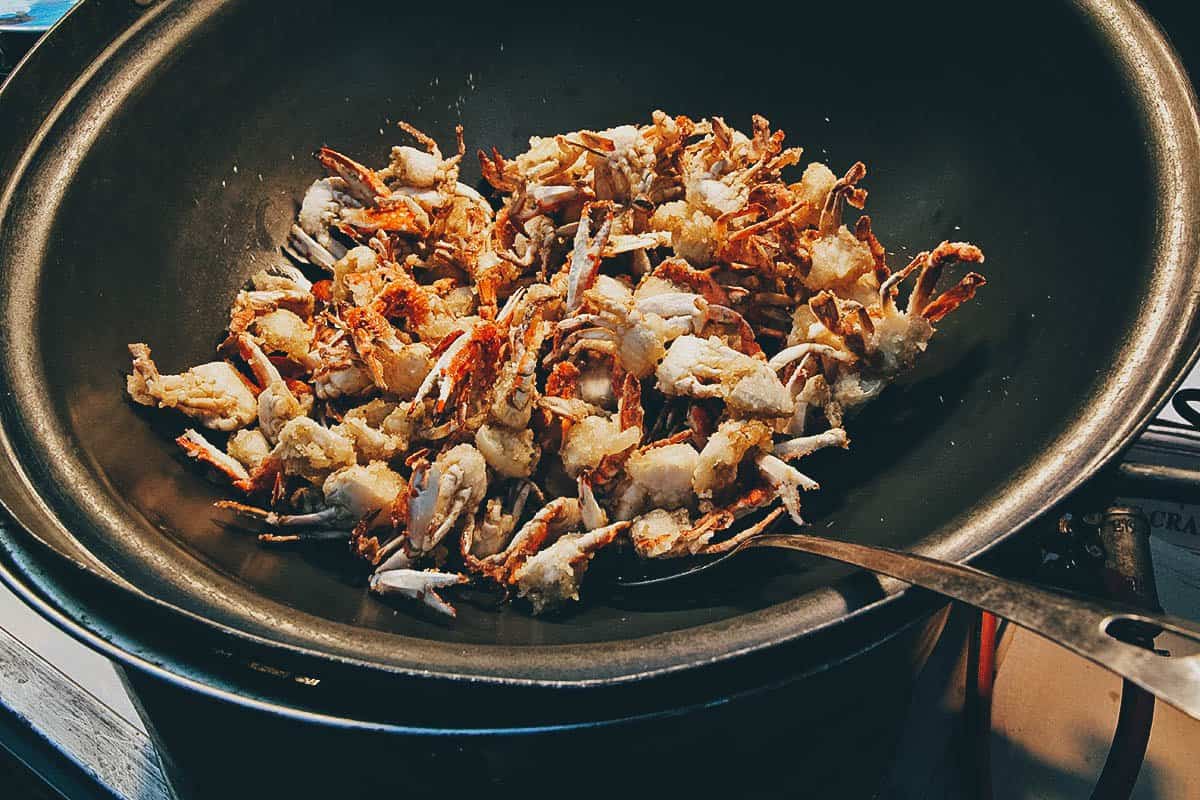

Where to Try it: Myeongdong Food Street
Expect to Pay: I’m guessing around KRW 4,000 per cup
Expect to Pay: I’m guessing around KRW 4,000 per cup
25. Dakkochi
These grilled chicken and scallion skewers are really good. Cut into narrow slices, the chicken is alternately skewered with scallions and brushed with a spicy-sweet red chili sauce. Don’t miss this!
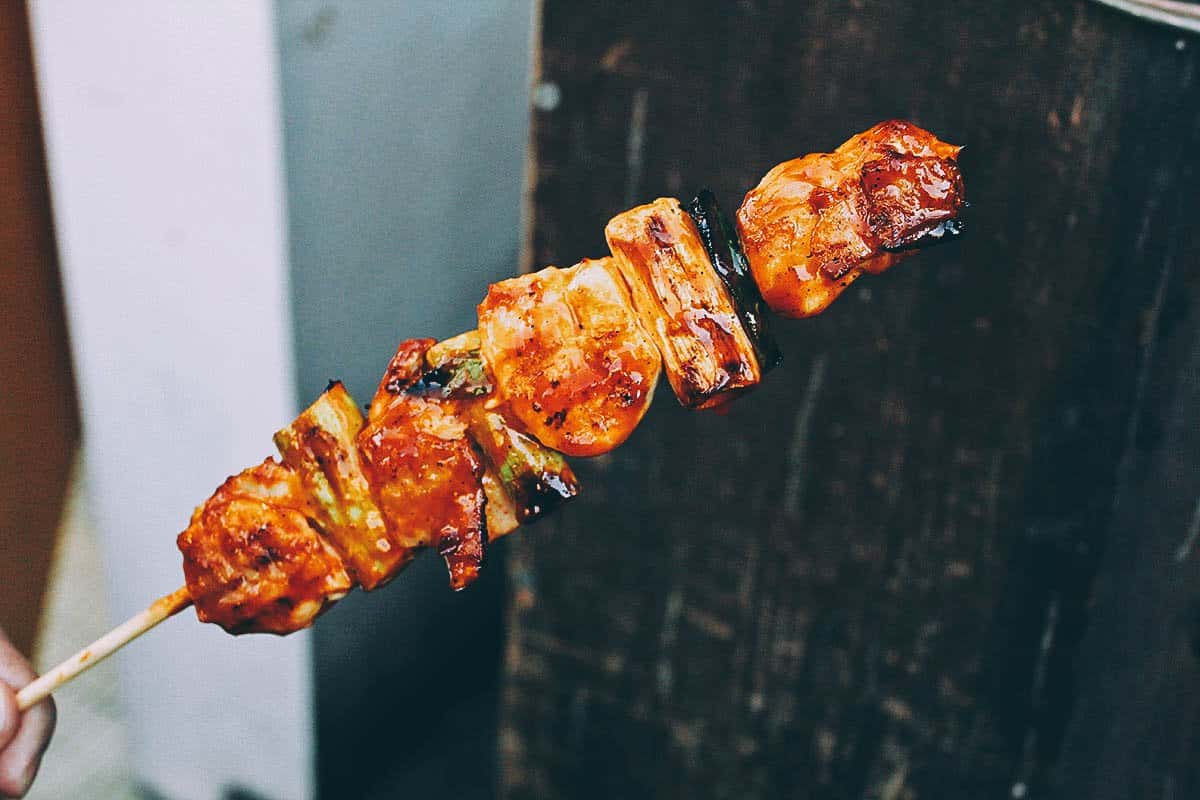

Where to Try it: Myeongdong Food Street
Expect to Pay: Around KRW 3,000 per stick
Expect to Pay: Around KRW 3,000 per stick
26. Ddongbbang
Shaped like cartoon poop, ddongbbang literally means “poo bread”. It’s a sweet, crisp, and doughy snack with a variety of fillings like warm red bean or chocolate. They’re made by a chain of poop bread shops appropriately called Dong Bang. I read that the chain started in Insadong so we may have gotten ours from the very first branch, in Ssamziegil Market.
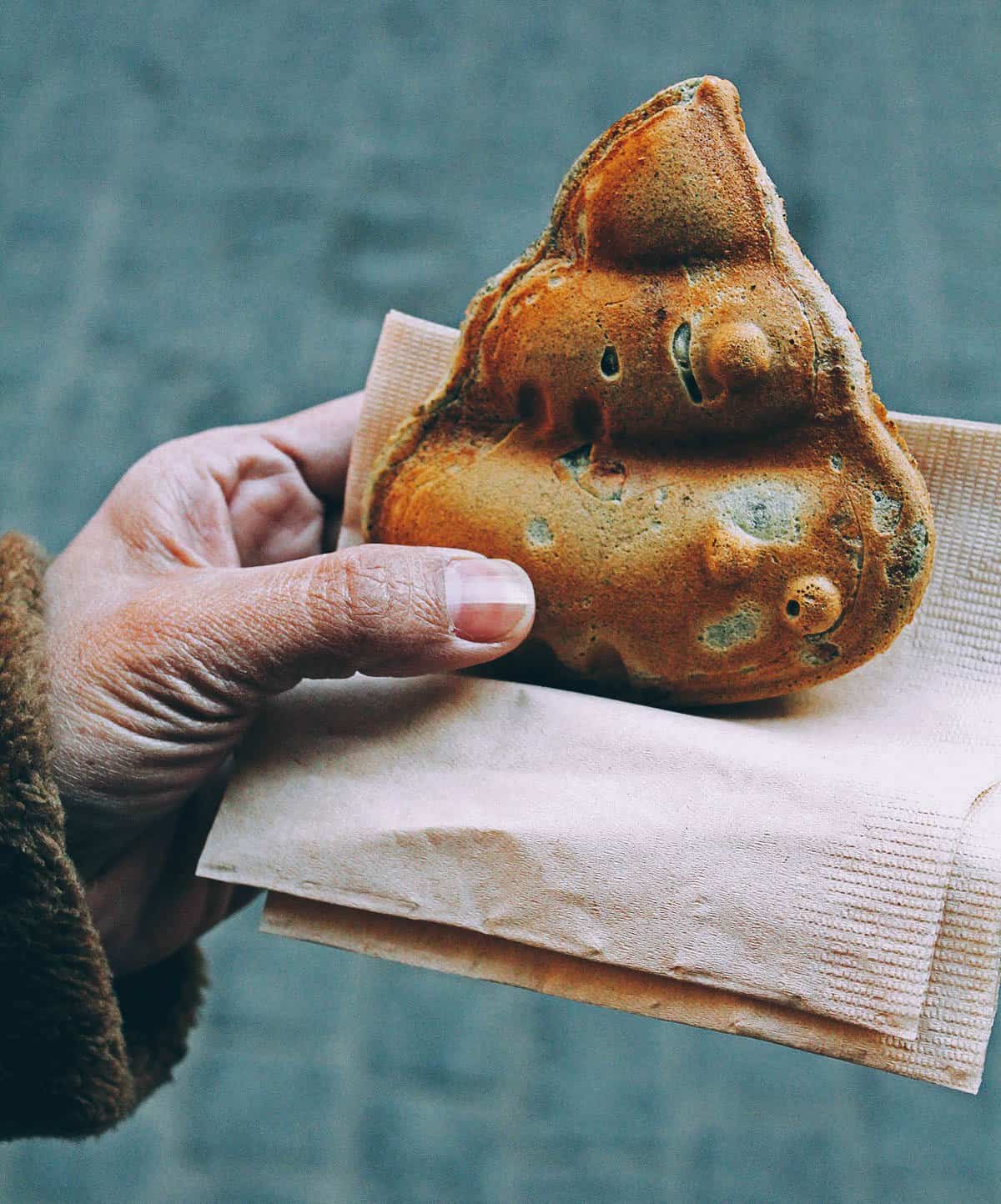
We tried the red bean and it was delicious, warm and nutty, just like the real thing. Kidding.
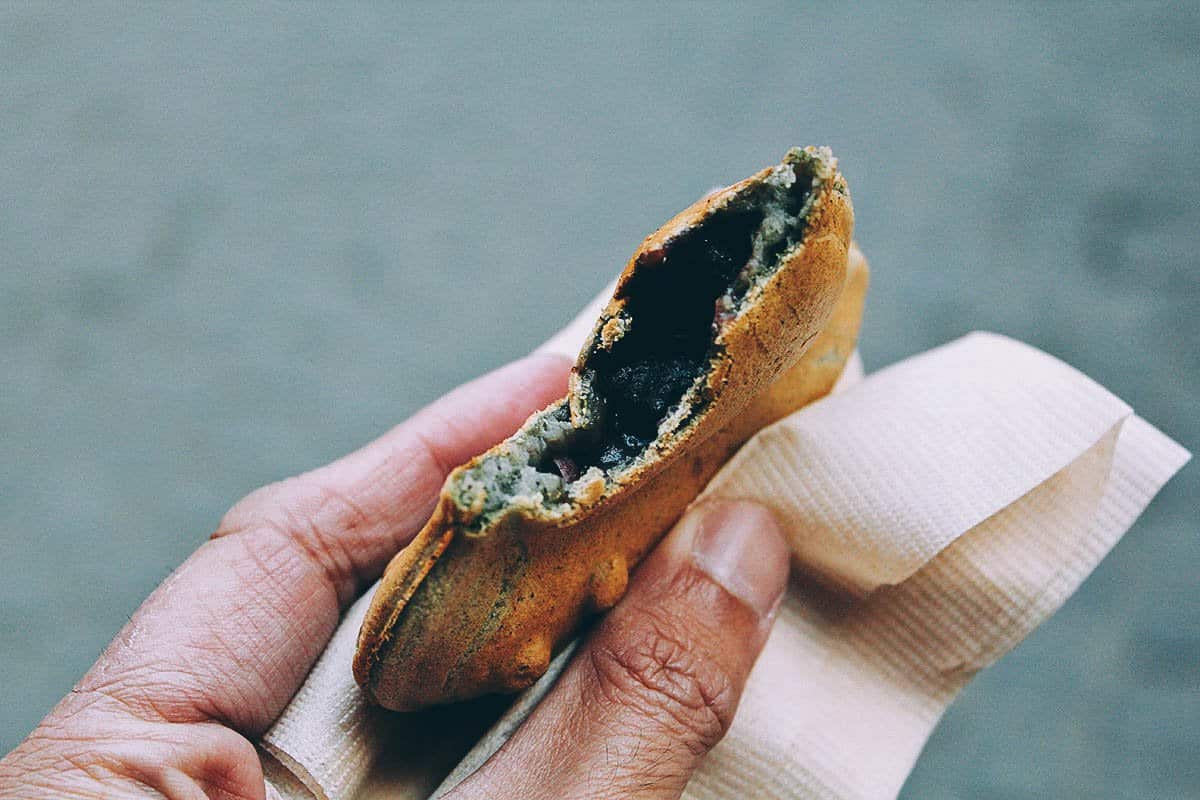

We tried the red bean and it was delicious, warm and nutty, just like the real thing. Kidding.

27. Dondurma
I’m not sure how dondurma or Turkish sticky ice cream became popular in Seoul, but you’ll find a few of these stalls in the city. Unlike regular ice cream, Turkish ice cream is made with salep, a flour made from the root of the early purple orchid, and mastic, a resin that imparts chewiness. The result is a stickier, chewier ice cream that doesn’t melt as quickly. Dondurma is available in multiple flavors and typically served in a cone, but we got ours sandwiched between two macaron cookies for KRW 4,000.
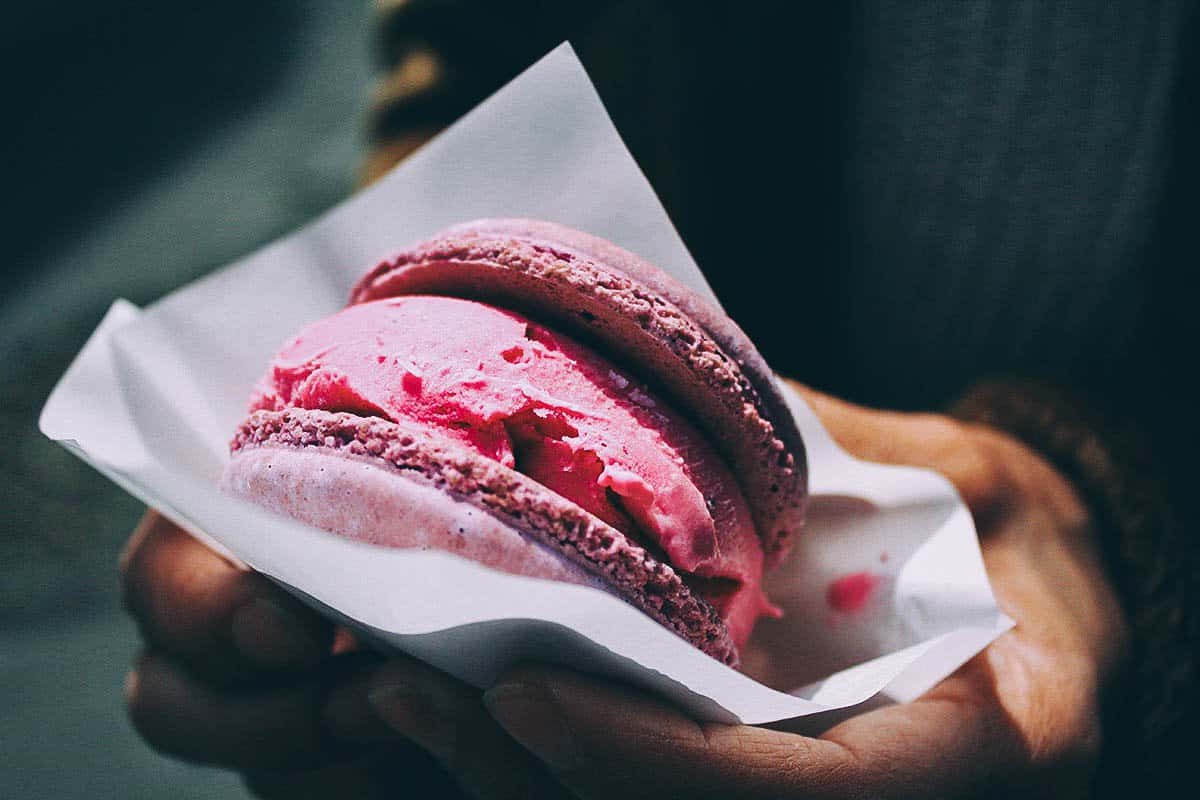

28. Eomuk / Odeng
Eumok (or odeng) refers to fishcake in Korean cuisine. It’s made with ground white fish and other ingredients like potato starch, sugar, and vegetables. Pictured below is eumok tang, or skewered fishcakes served in broth. Eumok is popular in Seoul and available pretty much anywhere. We had it at Everlandthough we saw it on Nami Island and Myeongdong as well.
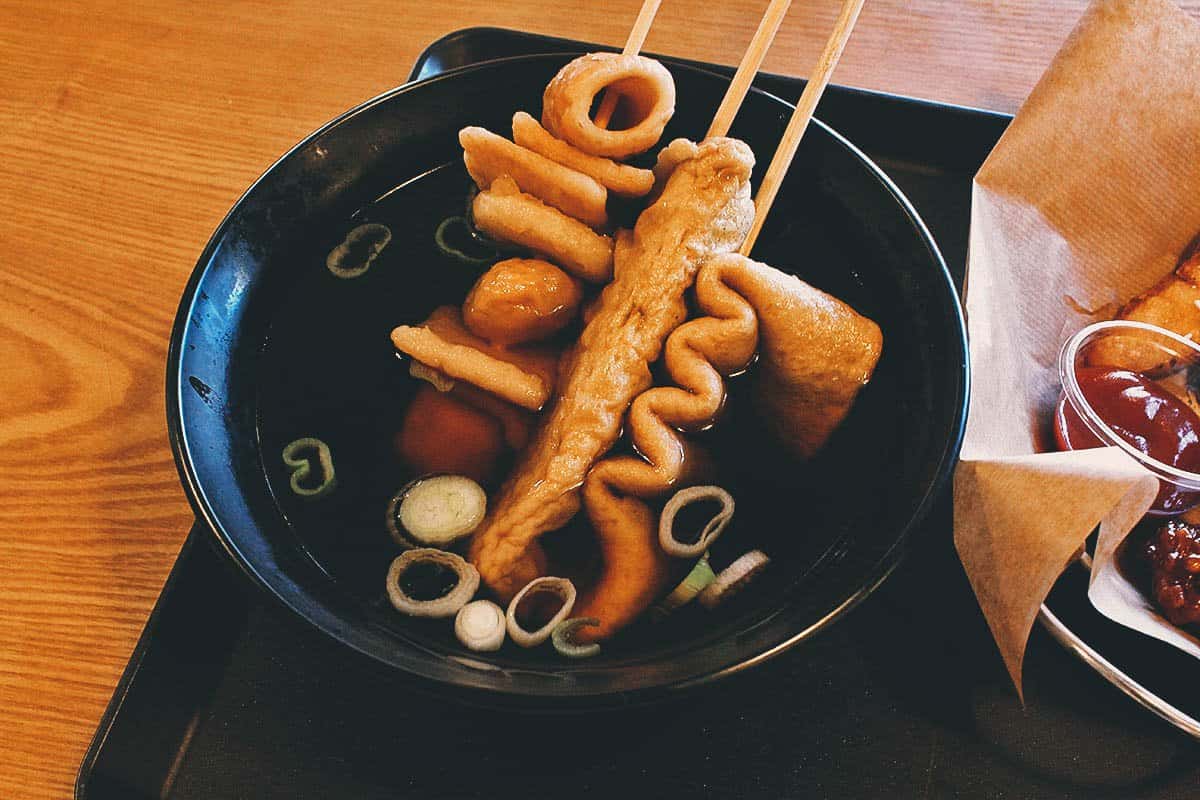
Eumok is also widely available in cylindrical form like this, often filled or mixed with other ingredients like cheese, vegetables, sausage, and tteokbokki.
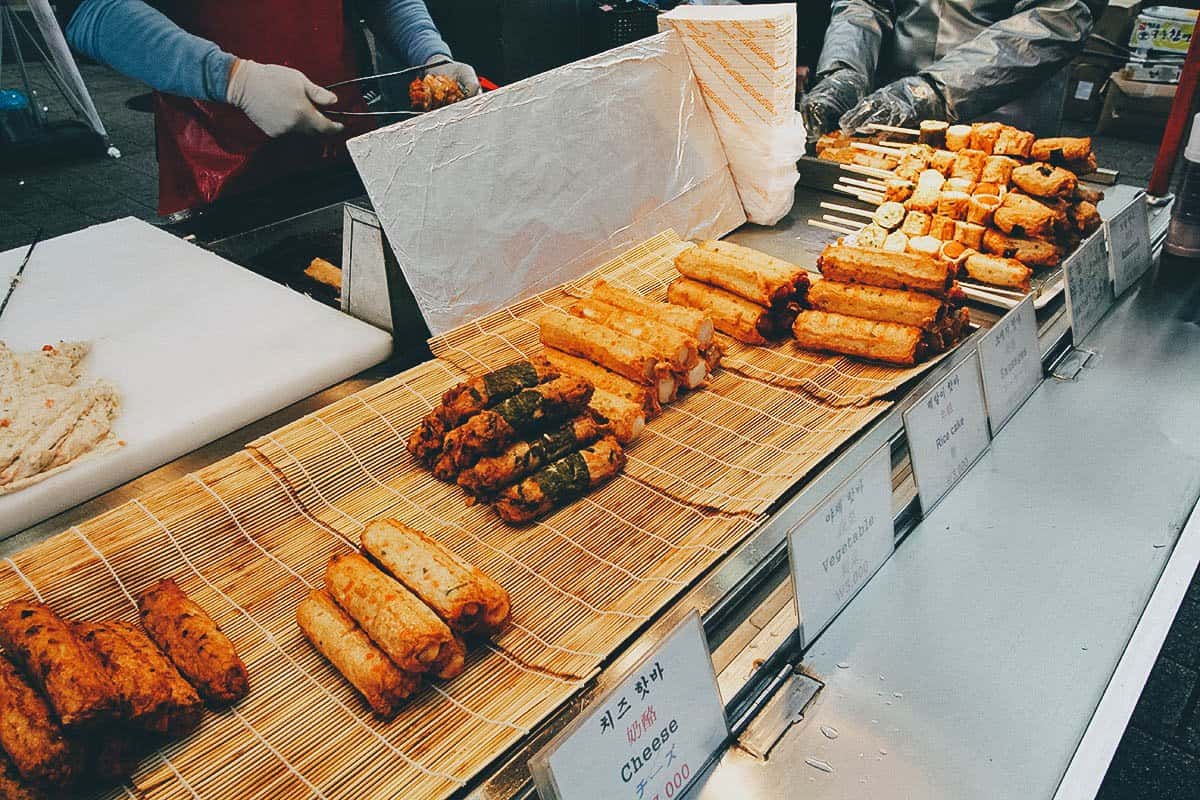

Eumok is also widely available in cylindrical form like this, often filled or mixed with other ingredients like cheese, vegetables, sausage, and tteokbokki.

Where to Try it: Myeongdong Food Street
Expect to Pay: Around KRW 3,000-5,000 per order
Expect to Pay: Around KRW 3,000-5,000 per order
29. Gyeranppang
This was one of my favorite street food snacks in Korea. Gyeranppang means “egg bread” and refers to these fluffy, oblong-shaped loaves of bread made with whole eggs. An entire egg is cracked into oblong-shaped slots filled with cake batter, then crisped until golden brown. They’re rich and eggy with a slightly crisp, chewy crust. Don’t miss these either.
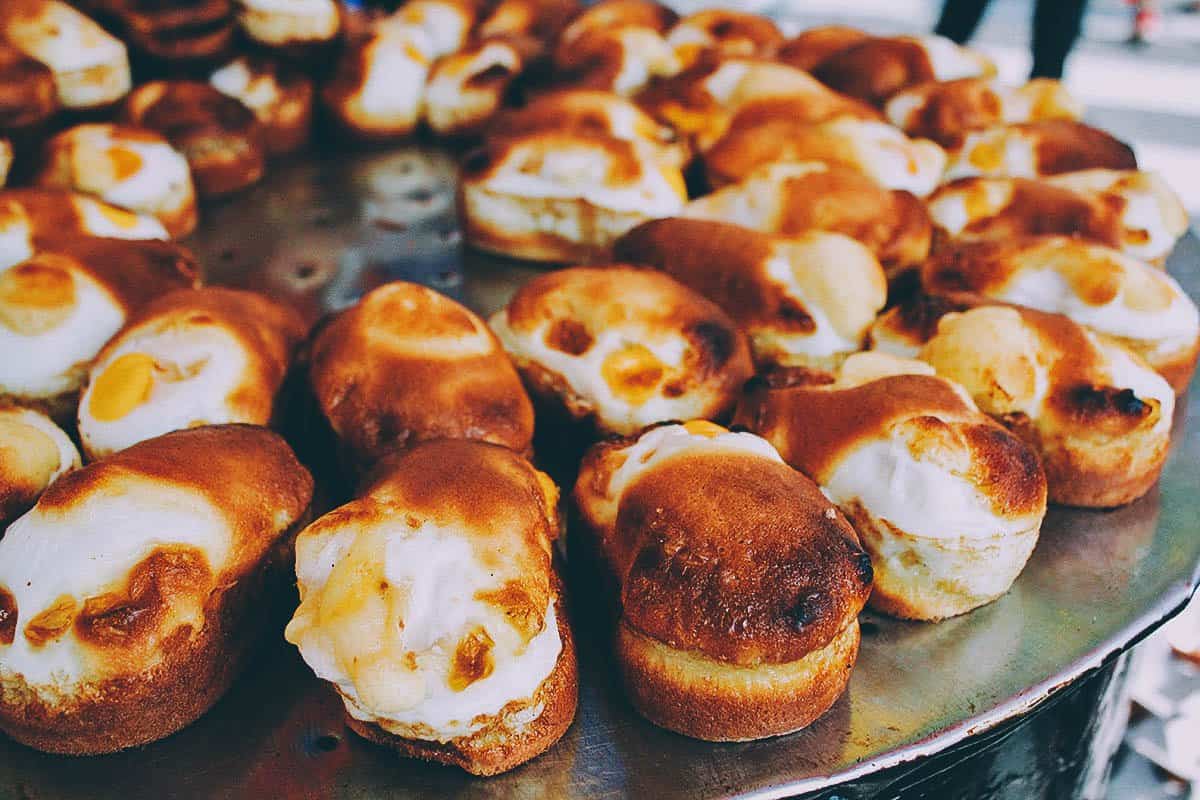

Where to Try it: Myeongdong Food Street
Expect to Pay: KRW 2,000 per piece
Expect to Pay: KRW 2,000 per piece
30. Hotteok
Hotteok is a sweet Korean pancake filled with a mixture of brown sugar, honey, chopped peanuts, and cinnamon. Filled balls of dough are placed on a greased griddle and pressed flat with a circular tool as it cooks.
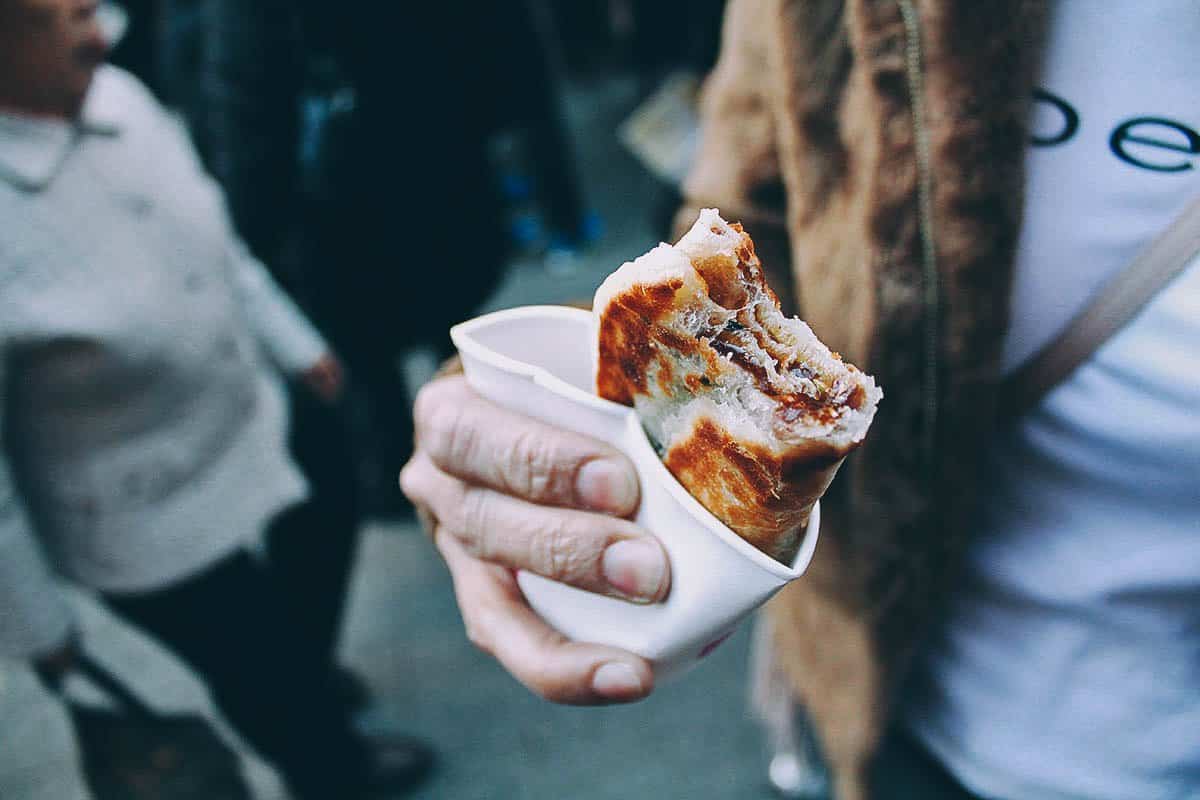

Where to Try it: Myeongdong Food Street
Expect to Pay: Around KRW 1,000-2,000 per piece
Expect to Pay: Around KRW 1,000-2,000 per piece
31. Jajangmyeon
Jajangmyeon is a Korean-Chinese dish with thick, hand-made (or machine-pulled) wheat noodles topped with a heavy sauce made from fried chunjang (sweet bean sauce), soy sauce, diced pork, and vegetables. What’s interesting about this dish is that it’s come to be associated with Black Day, an unofficial holiday celebrated on April 14 by unattached people in Korea. People who don’t receive gifts on Valentine’s Day or White Day drown their sorrows in a black bowl of jajangmyeon.
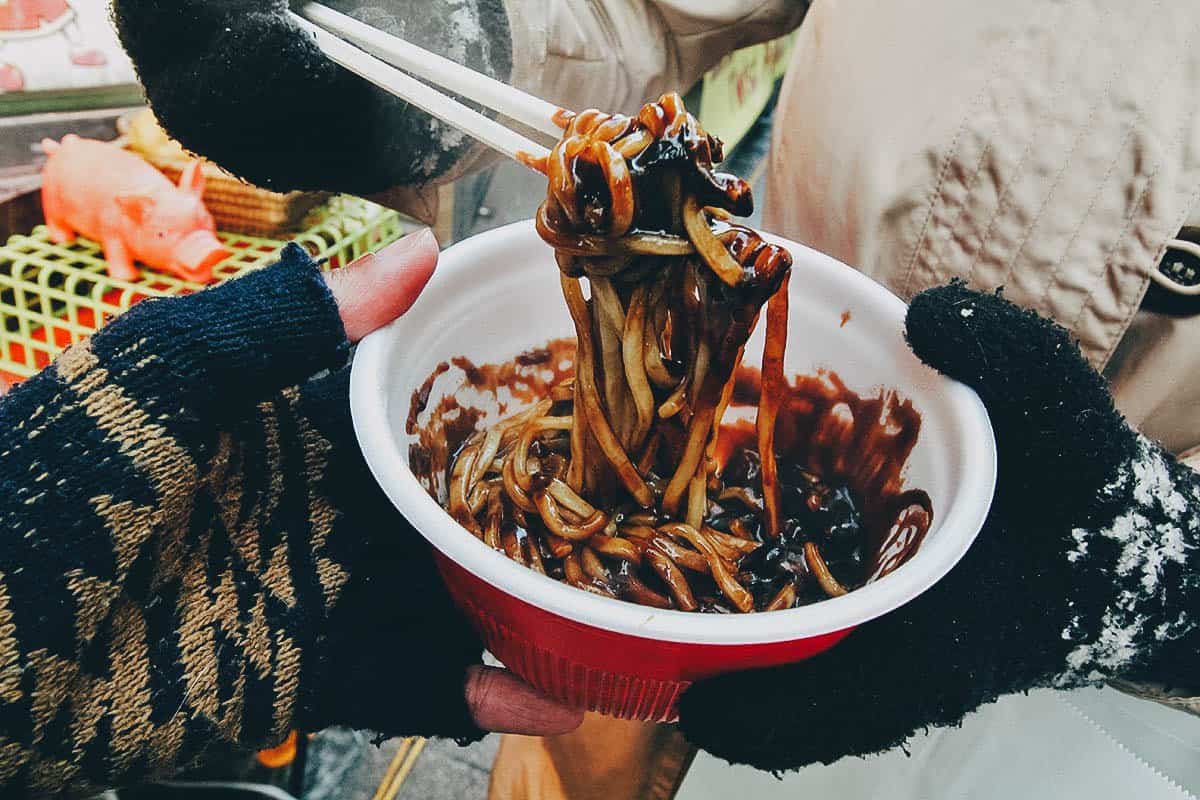

Where to Try it: Myeongdong Food Street
Expect to Pay: KRW 4,000 per bowl
Expect to Pay: KRW 4,000 per bowl
32. Jipangyi Cane Ice Cream
Part ice cream cone, part sex toy. This long and phallic J-shaped hollow cone is made with puffed rice or corn and filled with soft serve gelato ice cream. Jipangyi means “cane” in Korean, hence the shape. It’s a popular snack sold in many tourist areas like Insadong.
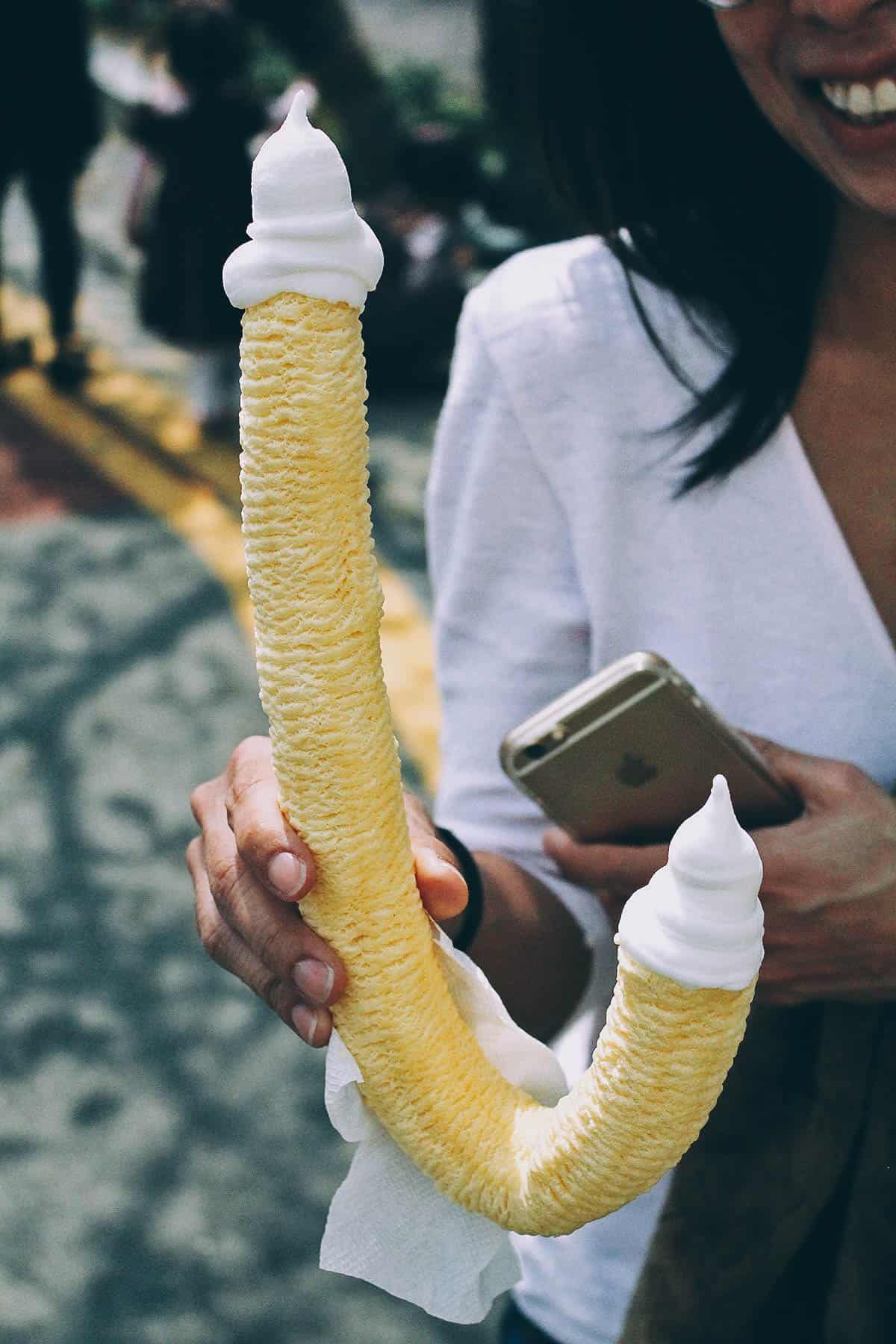

33. Lobster Tails
At KRW 15,000 each, these lobster tails are among the most expensive street food dishes you can try in Seoul, but they’re worth it. The meat is cut into chunks and blowtorched before being sprinkled on top with some shredded cheese. The cheese is then melted under a Zaigle or infrared grill, and finished off with some type of spicy red chili sauce. It’s decadent and delicious.
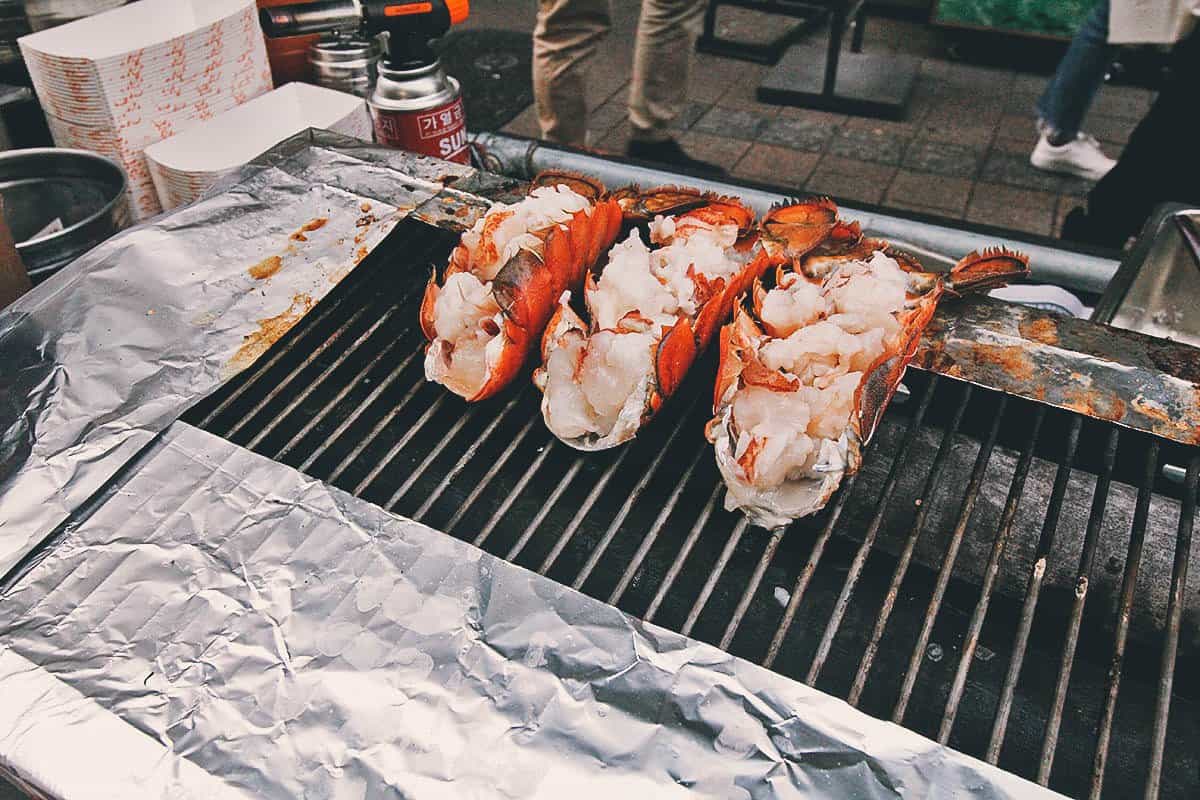

Where to Try it: Myeongdong Food Street
Expect to Pay: KRW 15,000 per lobster tail
Expect to Pay: KRW 15,000 per lobster tail
34. Mandu
Whether steamed, boiled, pan-fried, or deep-fried, mandu is the general term for Korean dumplings. They’re similar to Japanese gyoza or Chinese jiaozi, and typically served with kimchi and a soy-vinegar-chili dipping sauce. Ren and I shared this big platter of steamed (jjinmandu) and fried mandu (yaki mandu) at a restaurant in Insadong for KRW 12,000, but they’re widely available as street food as well.
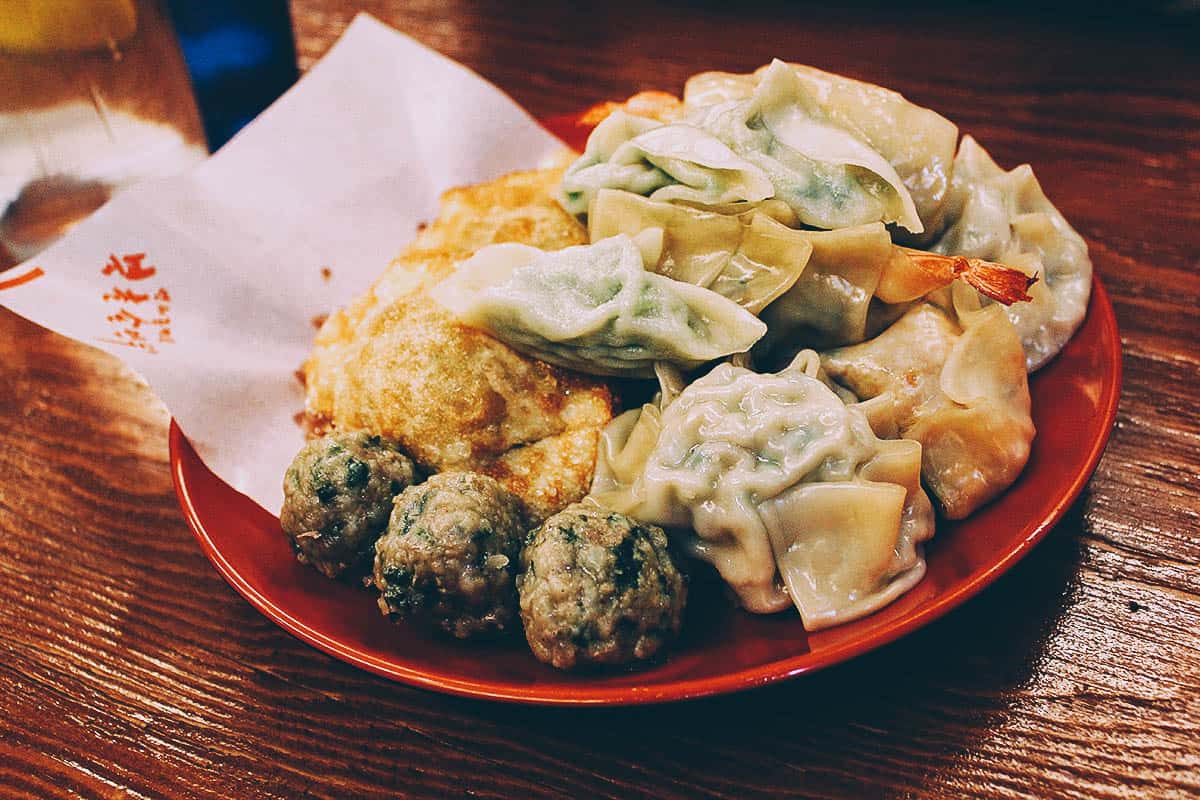
Pictured below is a bigger type of mandu called wang mandu. Filled with pork and vegetables, they reminded me of a cross between a siopao and a dumpling. We had three of these bad boys for KRW 2,000 at Nandaemun Market.
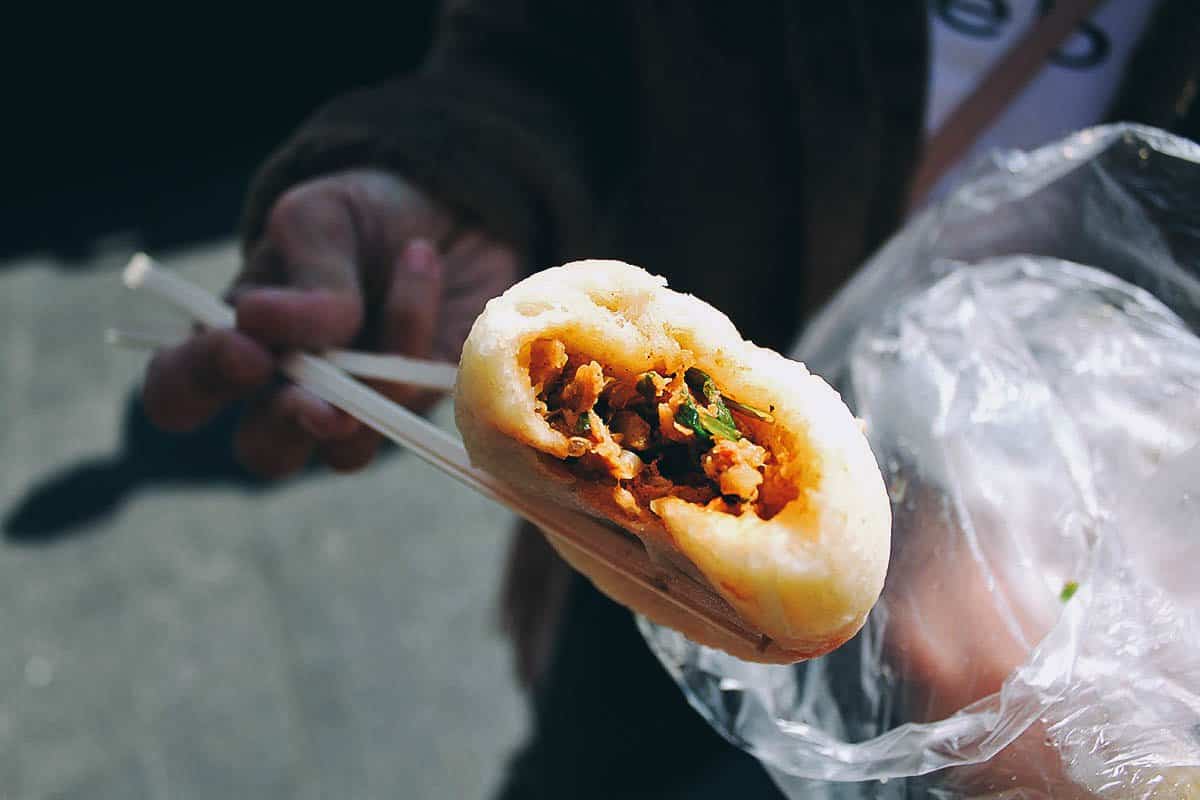

Pictured below is a bigger type of mandu called wang mandu. Filled with pork and vegetables, they reminded me of a cross between a siopao and a dumpling. We had three of these bad boys for KRW 2,000 at Nandaemun Market.

Where to Try it: Myeongdong Food Street
Expect to Pay: KRW 4,000-5,000 per small plate
Expect to Pay: KRW 4,000-5,000 per small plate
35. Mozzarella & Tteokbokki Skewers
These are grilled skewers with alternating pieces of mozzarella and tteokbokki. They’re rich, milky, creamy, and chewy. They’re really good, just don’t eat too many of them as they’re quite filling.
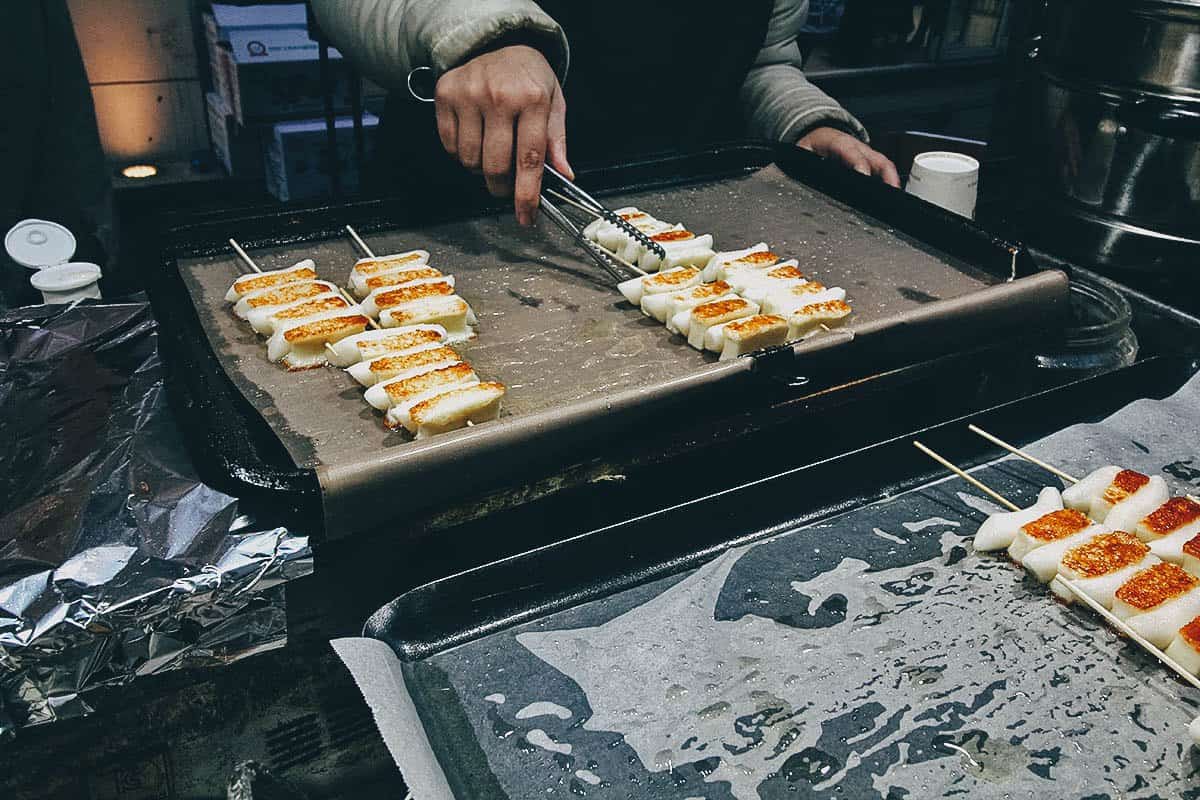

Where to Try it: Myeongdong Food Street
Expect to Pay: KRW 3,000 per stick
Expect to Pay: KRW 3,000 per stick
36. Sausage & Tteokbokki Skewers
I think there are a few variations of these grilled sausage and tteokbokki skewers. Some have beef while others like this one are made with eumok wrapped around rice cakes. If I remember correctly, the sausages were filled with cheese.
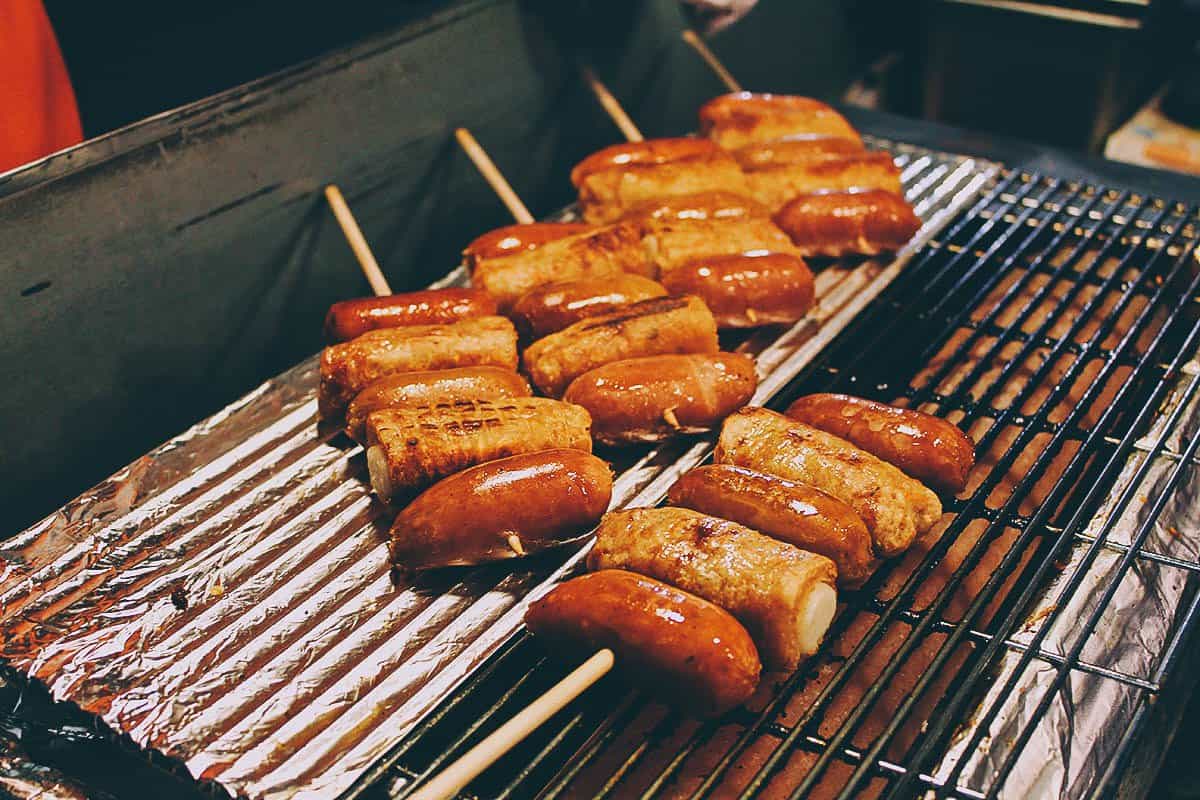

Where to Try it: Myeongdong Food Street
Expect to Pay: Around KRW 4,000 per stick
Expect to Pay: Around KRW 4,000 per stick
37. Scallops with Butter & Cheese
Like the lobster tails, these torched scallops are among the more expensive street food dishes in Seoul. They cost KRW 10,000 per shell. The scallops are drizzled with butter and cheese, then set on fire with a blowtorch. It makes for a good show and some tasty scallops.
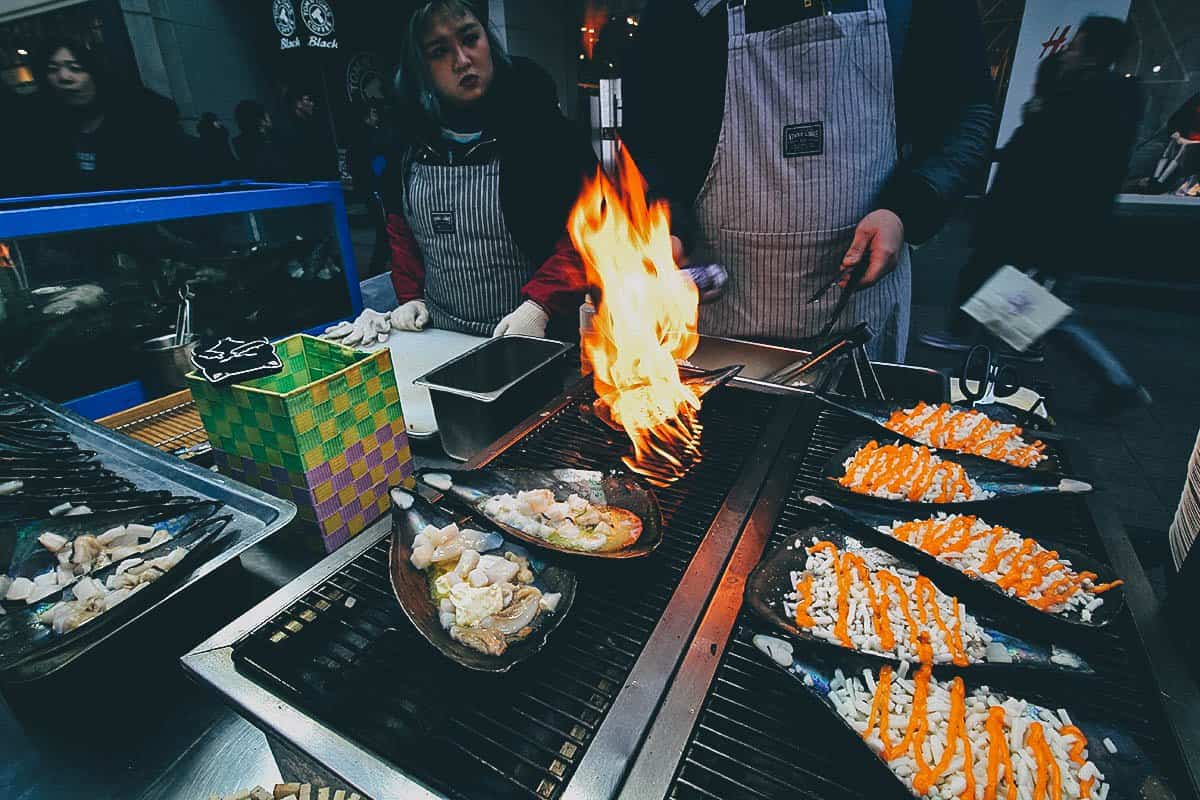

Where to Try it: Myeongdong Food Street
Expect to Pay: KRW 10,000 per large shell
Expect to Pay: KRW 10,000 per large shell
38. Schnee Pang
Like dondurma which has foreign roots, schnee pang is a cookie/pastry that originated in Germany (called “schneeball”), but has somehow found a home in Seoul. It’s made by cutting strips of rolled out shortcrust dough and arranging them into balls. The ball is then deep-fried and dusted with confectioner’s sugar or coated with other toppings. Before serving, they put the ball into a paper bag and smash it into bite-sized pieces with a hammer. The cookie has a crunchy texture similar to Chinese-American fortune cookies.
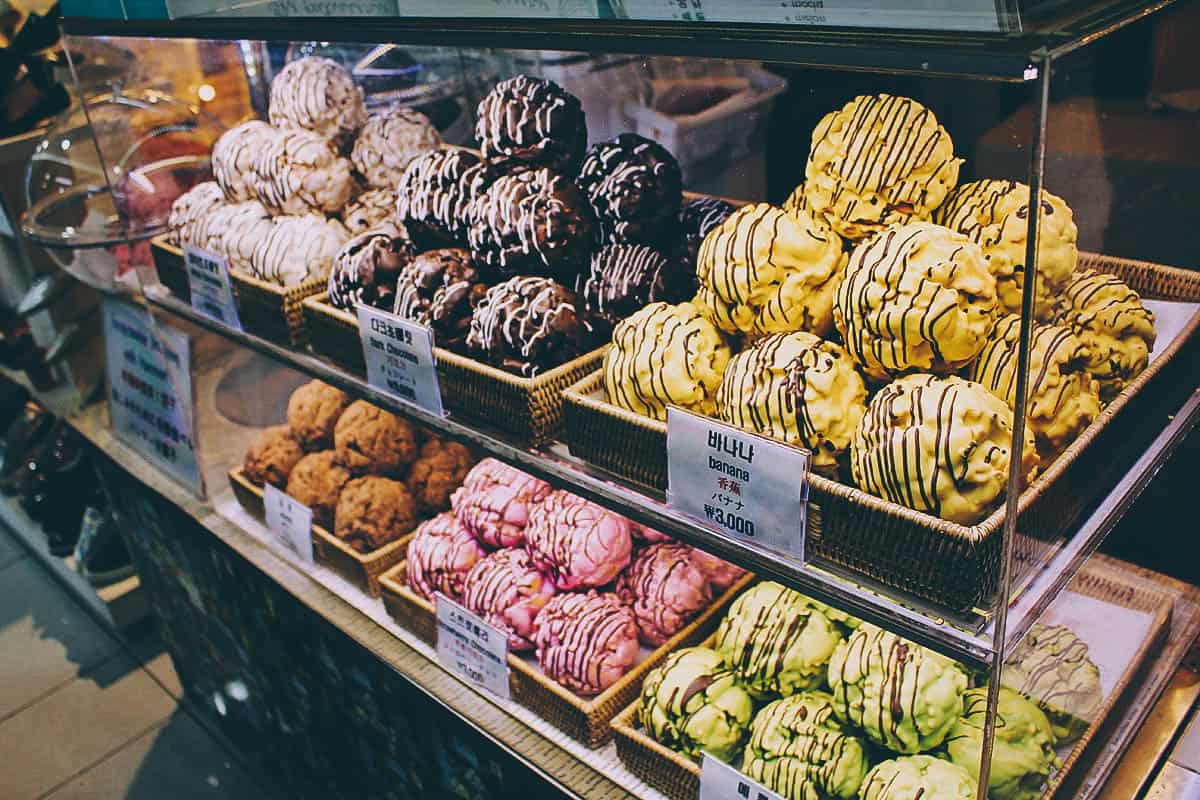

Where to Try it: Myeongdong Station (near Exits 2 & 3)
Expect to Pay: KRW 3,000 per ball
Expect to Pay: KRW 3,000 per ball
39. Soondae
Soondae is a Korean blood sausage made by boiling or steaming cow’s or pig’s intestines stuffed with various ingredients. They can be made with seafood like squid or Alaskan pollock, but the most common variety is made with pig’s intestines filled with dangmyeon (cellophane noodles), barley, and pork blood. It’s a popular street food snack in both North and South Korea. In the South, they’re typically eaten with the same gochujang-based sauce used with tteokbokki.
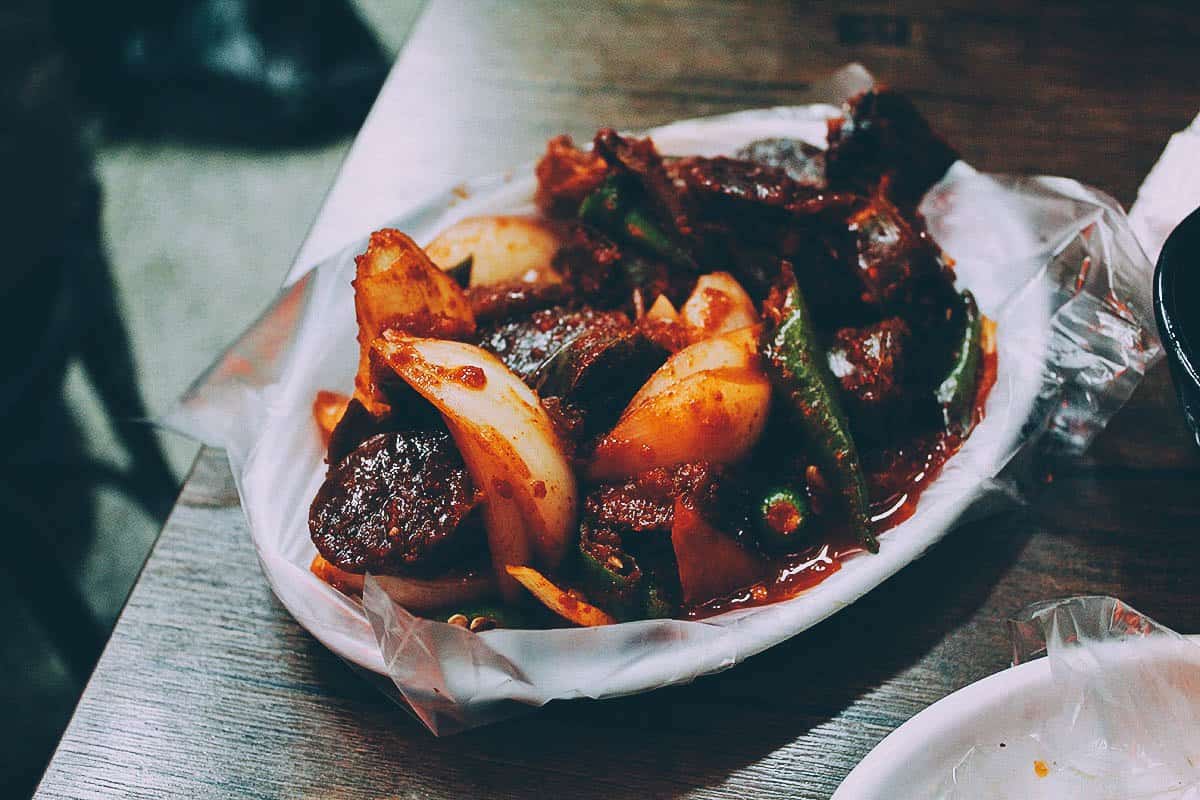

Where to Try it: Myeongdong Food Street, Gwangjang Market, Nandaemun Market
Expect to Pay: Around KRW 5,000 per plate
Expect to Pay: Around KRW 5,000 per plate
40. Steamed Octopus & Conch
This was another popular street food snack that we saw in many tourist areas. Octopus and conch are cut into bite-sized pieces before being skewered and steamed, then served with a side of red chili sauce. Some vendors drizzle them with bonito flakes.
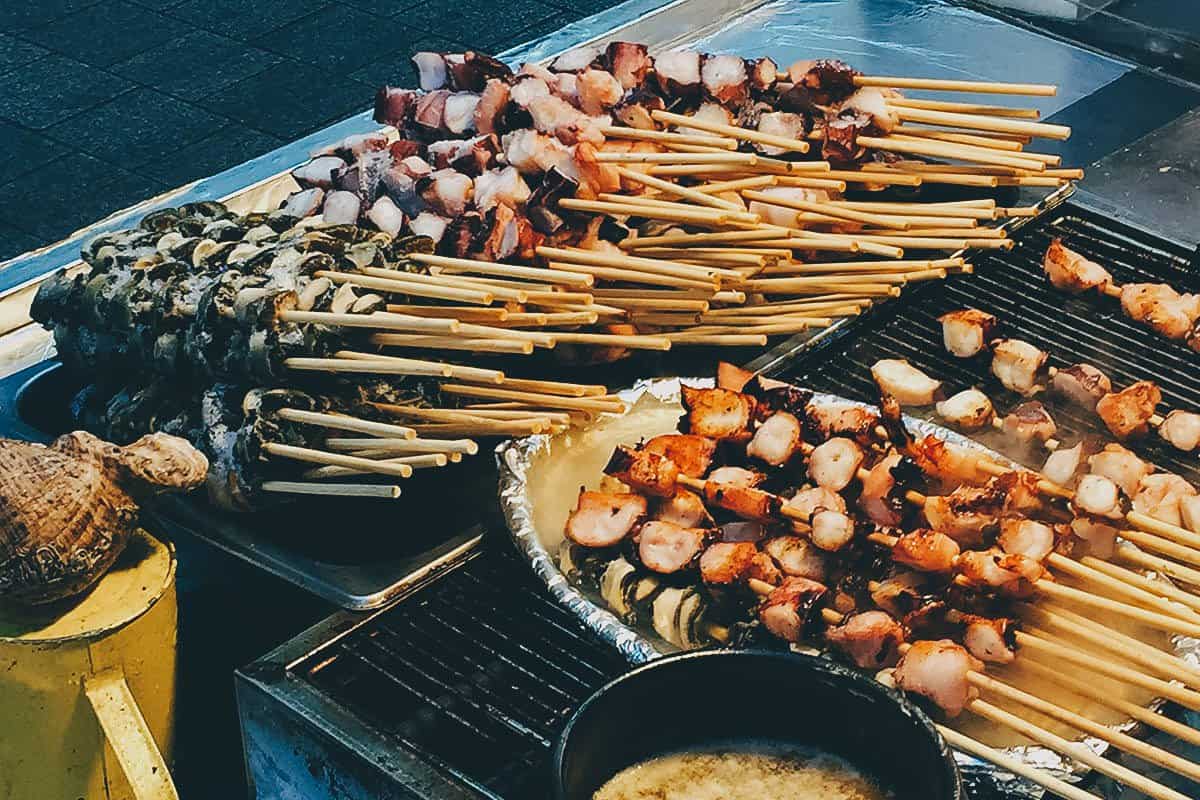

Where to Try it: Myeongdong Food Street, Insadong
Expect to Pay: Around KRW 3,000 per stick
Expect to Pay: Around KRW 3,000 per stick
41. Tokkebi Hot Dog
A tokkebi hot dog is basically a corn dog coated in chopped up french fries. It’s typically served with mayonnaise, chili sauce, and/or mustard.
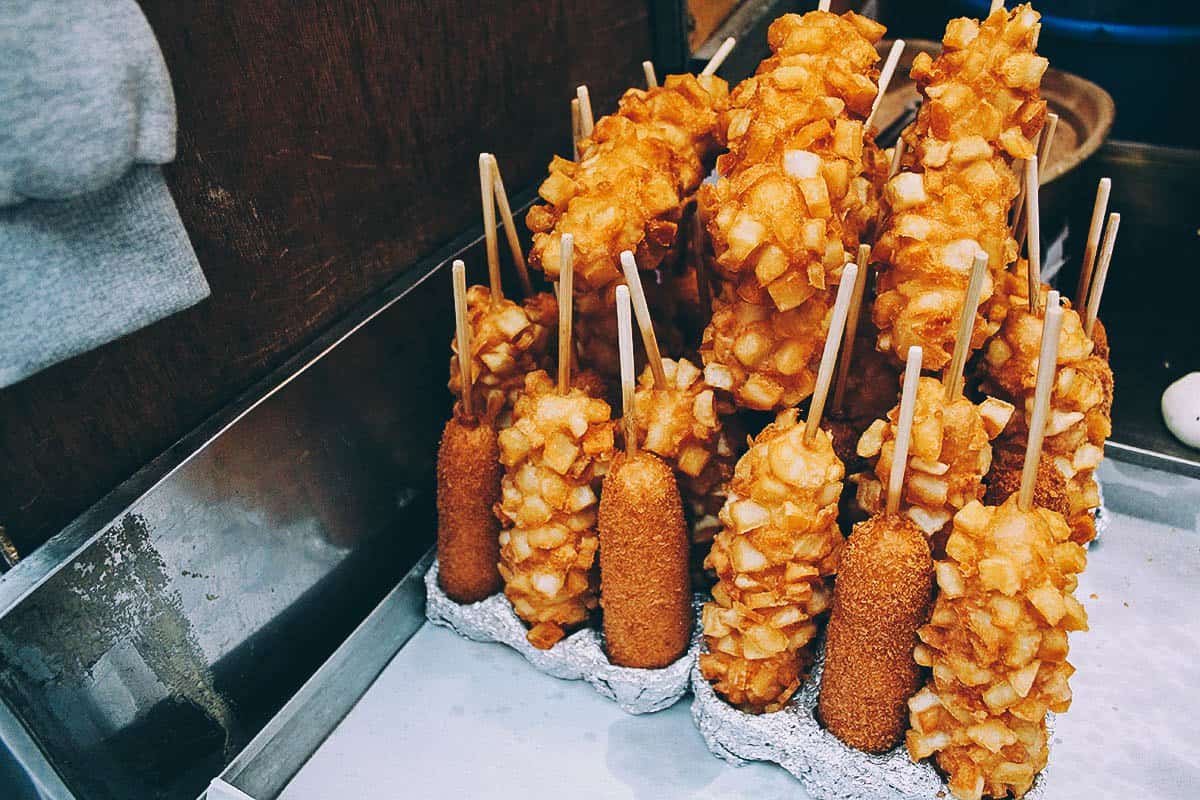

Where to Try it: Myeongdong Food Street
Expect to Pay: Around KRW 3,000 per stick
Expect to Pay: Around KRW 3,000 per stick
42. Tornado Potato
This corkscrew-like snack is another popular Korean street food. Think of it as a cross between french fries and potato chips. Some versions even have a hot dog running through the center of the potato spiral.
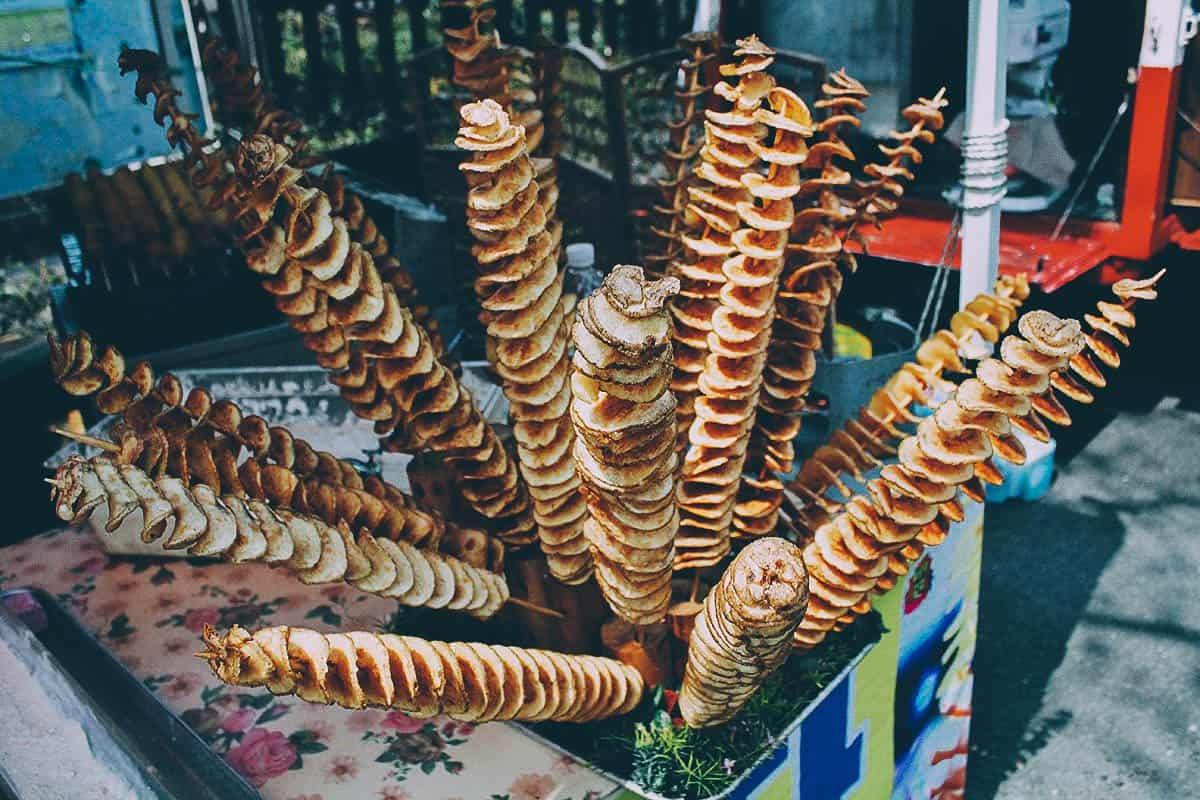

Where to Try it: Myeongdong Food Street
Expect to Pay: Around KRW 4,000 per stick
Expect to Pay: Around KRW 4,000 per stick
43. Tteokbokki
Tteokbokki is one of the most popular things to eat in Korea. Every market we visited had it, as did a few subway stations. It’s widely available on its own as street food or mixed in with other dishes like fried chicken or jjukumi. Tteokbokki is made from soft cylindrical-shaped rice cakes mixed with fish cake and drizzled with a spicy gochujang-based sauce or a non-spicy ganjang-based sauce.
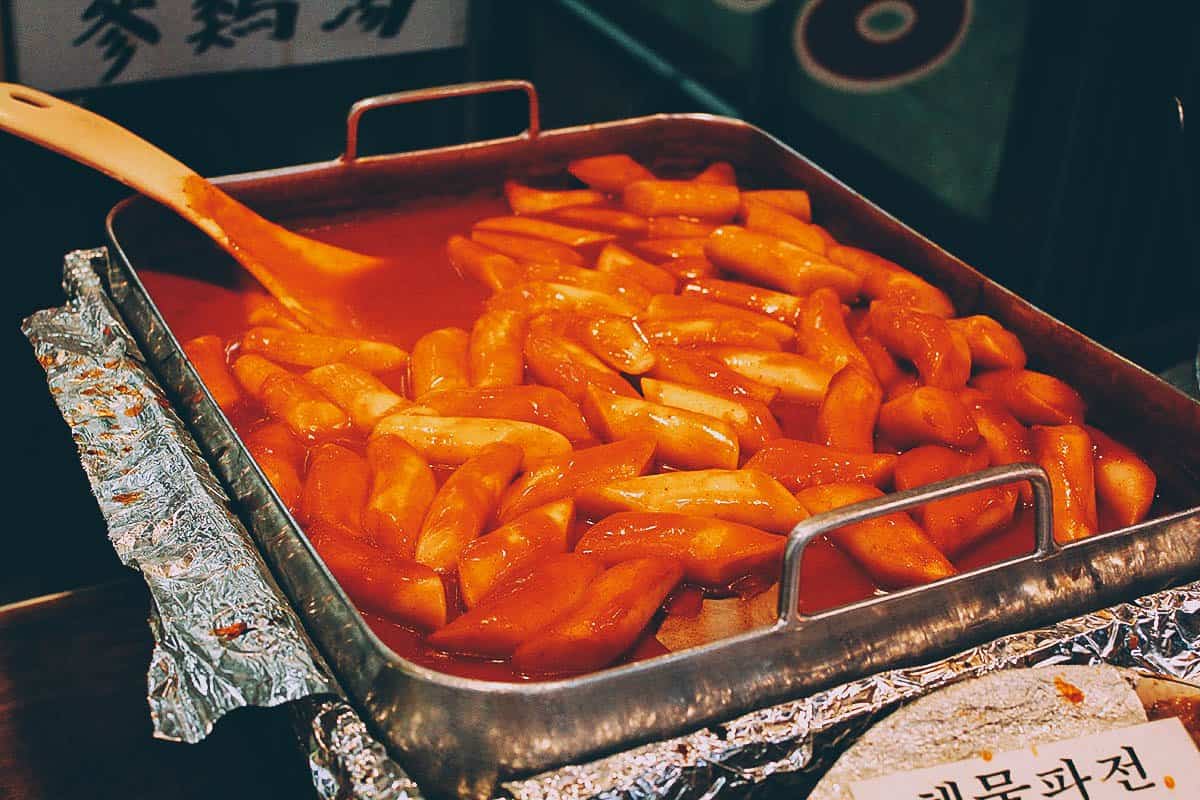

Where to Try it: Myeongdong Food Street, Gwangjang Market, Nandaemun Market
Expect to Pay: Between KRW 2,500-3,500 per cup
Expect to Pay: Between KRW 2,500-3,500 per cup
44. Twigim
Twigim is basically Korean-style tempura. It can be made with shrimp, squid, and different types of vegetables.
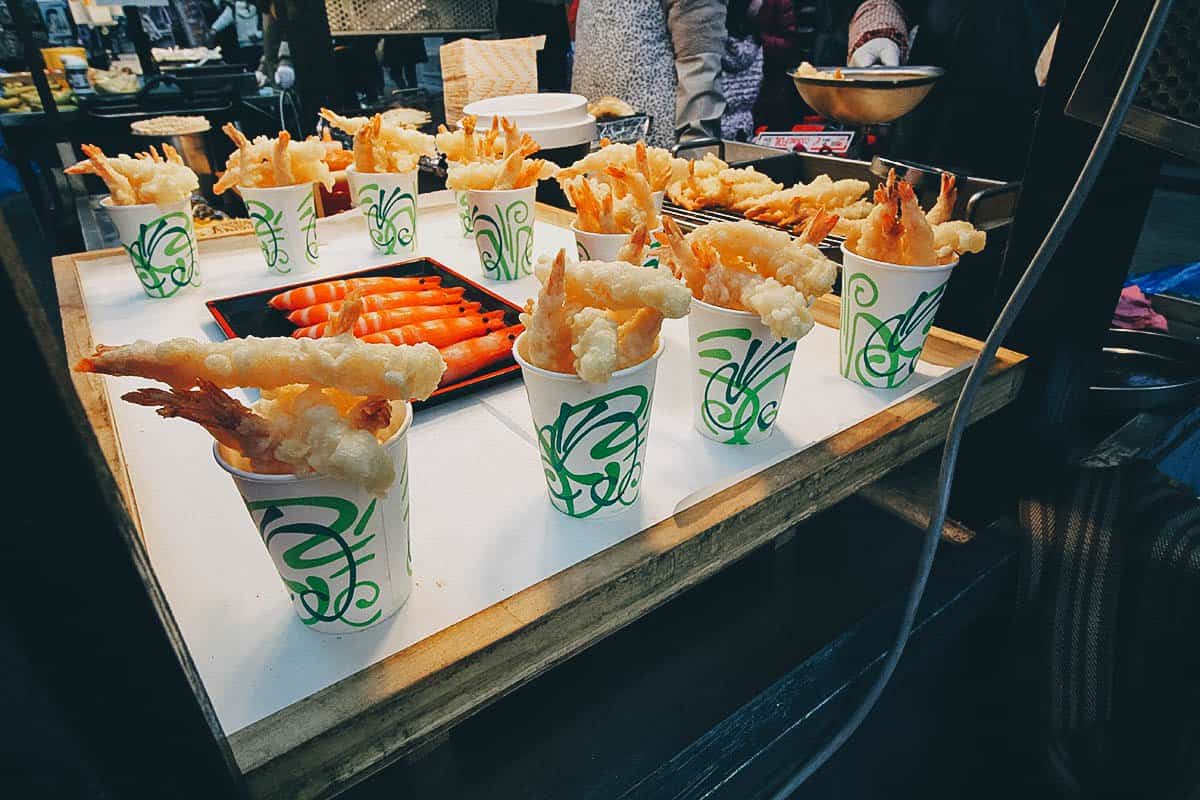

Where to Try it: Myeongdong Food Street
Expect to Pay: Around KRW 5,000 per cup
Expect to Pay: Around KRW 5,000 per cup
Conclusion
The first version of this post, which I wrote after our 2015 trip, consisted of 20 dishes. Two years and a second trip later, and it’s more than doubled to 44. Needless to say, this is a list I plan on updating and expanding with every return trip to Korea. With so much yet to experience, we want to explore other cities and regions in South Korea to further our knowledge of Korean food. With a cuisine this tasty, can you really blame us?
I’ve already mentioned several restaurants above, but now that you know WHAT you should eat in Korea, find out WHERE you should eat them by checking out our guide on 22 Must-Eat Restuarants in Seoul, South Korea. Thanks for visiting our blog and have an awesome time traveleating in Seoul!
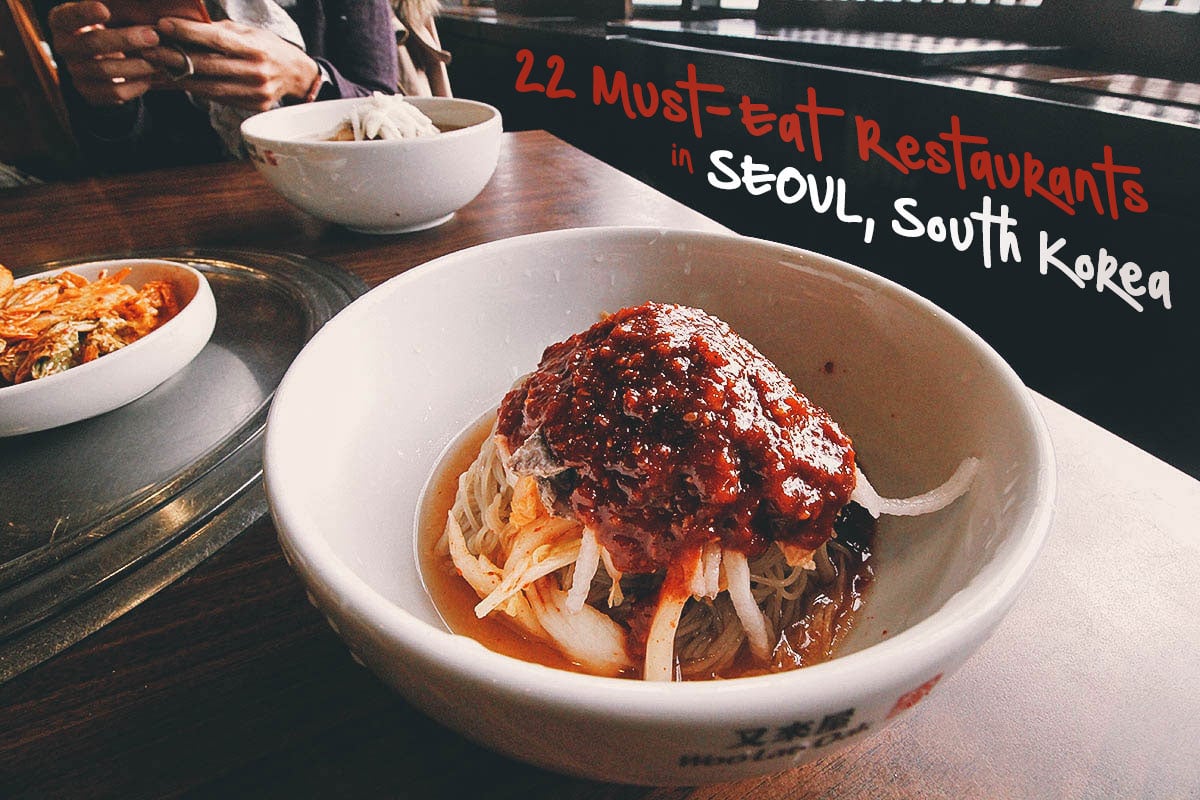

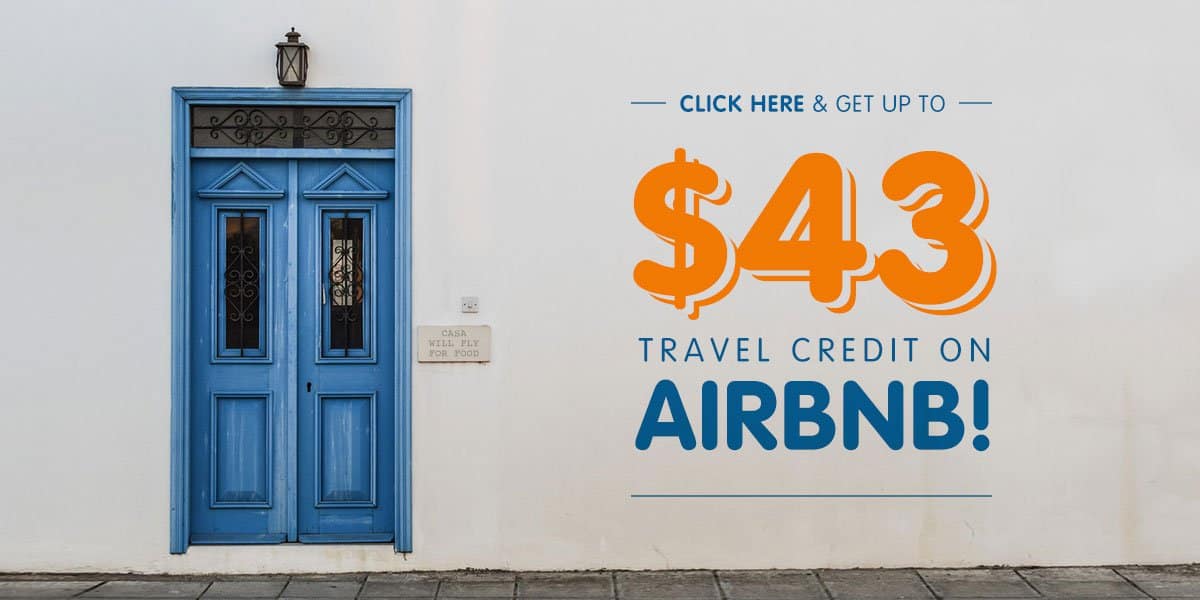
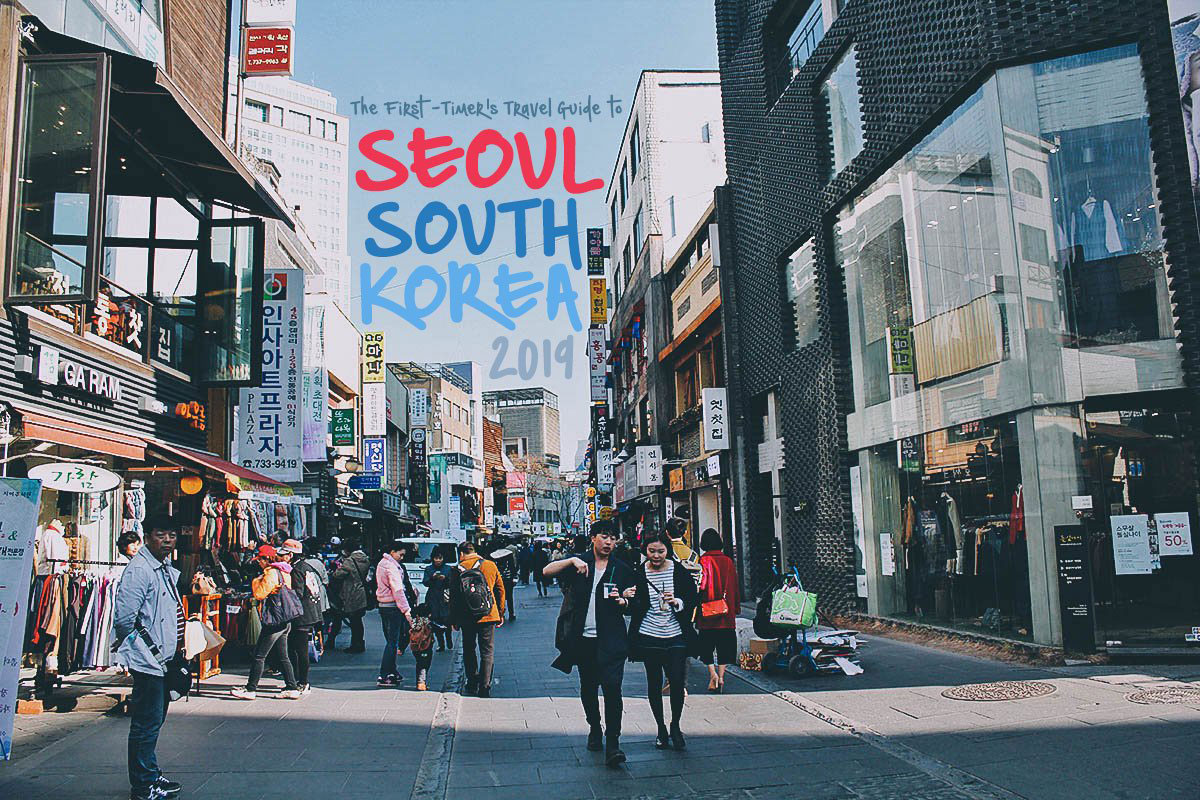
Comments
Post a Comment